 Charles Spencer Chaplin (April 16, 1889 to December 25, 1977) | |||
 Compositions Compositions | |||
|
(Note that many dates shown represent known or approximate composition dates rather than copyright, since some pieces associated with films were not published or copyrighted until some time after the film's release.)
| |||
 Discography Discography | |||
|
1925
With You, Dear, In Bombay [9]Sing a Song [9,10]
9. Conducting the Abe Lyman Orchestra
10. Vocal by Charles Kaley |
Matrix and Date
[Brunswick 15849/50] 05/??/1925[Brunswick 15872] 05/??/1925 | ||
 Pieces About or Associated With Charlie Chaplin Pieces About or Associated With Charlie Chaplin | |||
|
1915
That Charlie Chaplin Walk [William S. Downs & Roy Barton]The Charlie Chaplin Glide [Gordon Strong] The Charlie Chaplin Trot [Gustave Leon] The Charlie Chaplin ["Pauline"] (c.1915) Those Charlie Chaplin Feet [Edgar Leslie & Archie Gottler] Funny Charlie Chaplin [James G. Ellis] Charlie Chaplin's Frolics: Eccentric Dance [Theodore Bonheur] Charlie! Charlie! [Herman Darewski & Dan Lipton] Broadway Is My Home Sweet Home [Meyer Davis, Uriel Davis & Donald M. McLeran] The Moon Shines Bright on Charlie Chaplin (Parody) [Unknown author - Melody of Red Wing by Kerry Mills] 1920
At the Moving Picture Ball [Howard Johnson & Joseph H. Santly]1921
The Kid (Introduced in 'The Kid') [Joe Bren & Haven Gillespie]Charlot (French Fox Trot) [Harold de Mozi, Henry Moreau & Jack Cazol] 1924
Mandalay [Earl Burtnett, & Abe Lyman]1939
Who is This Man (Who Looks Like Charlie Chaplin?) [Tommy Handley] | |||
 Filmography Filmography | |||
|
Keystone Studios
1914
Making a LivingMabel's Strange Predicament Kid's Auto Race at Venice A Thief Catcher (Found 2010) Between Showers A Film Johnnie Tango Tangle (Charlie's Recreation) His Favorite Pastime Cruel, Cruel Love The Star Boarder (The Landlady's Pet) Mabel at the Wheel Twenty Minutes of Love [1] Caught in a Cabaret [1] Caught in the Rain [1] A Busy Day [1] The Fatal Mallet Her Friend the Bandit (Lost) [1] The Knockout Mabel's Busy Day Mabel's Married Life [1] Laughing Gas [1] The Property Man [1] The Face on the Barroom Floor [1] Recreation [1] The Masquerader [1] His New Profession [1] The Rounders [1] The New Janitor [1] Those Love Pangs (The Rival Mashers) [1] Dough and Dynamite [1] Gentlemen of Nerve [1] His Musical Career (The Musical Tramp) [1] His Trysting Places [1] Tillie's Punctured Romance [1] Getting Acquainted (A Fair Exchange) [1] His Prehistoric Past [1] Essanay Film Manufacturing Company
1915
His New JobA Night Out The Champion In the Park A Jitney Elopment The Tramp By the Sea Work A Woman The Bank His Regeneration (Cameo only) Shanghaied A Night in the Show Burleque on 'Carmen' 1916
PoliceLife (Unfinished -included in Triple Trouble) A Chaplin Snippet (Unknown Origin. Filmed at a February 1916 Benefit at the New York Hippodrome) 1918
Triple Trouble
1. Keystone Films Directed by Chaplin
All other non-Keystone Films Directed by Charles Chaplin |
Mutual Film Corporation
1916
The FloorwalkerThe Fireman The Vagabond One A.M. The Count The Pawnshop Behind the Screen The Rink 1917
Easy StreetThe Cure The Immigrant The Adventurer Chaplin Studios
1918
How to Make MoviesVarious Scenes with Harry Lauder Scenes shot with Visiting Celebrities First National
1918
A Dog's Life [2]The Bond Shoulder Arms [2] 1919
Sunnyside [2]1921
A Day's Pleasure [2]The Kid [2] The Idle Class [2] 1922
Pay Day [2]1923
The Pilgrim [2]United Artists
1923
A Woman of Paris [2]1925
The Gold Rush1928
The Circus [2,4]1931
City Lights [2]1936
Modern Times [2]1940
The Great Dictator [2,3]1942
The Gold Rush [Redux] [2]1947
Monsieur Verdoux [2,3]1952
Limelight [2,4]1957
A King in New York [2]1959
The Chaplin Revue (Compilation) [2]1967
A Countess from Hong Kong [2]Roy Export Company
1975
The Gentleman Tramp2004
The Life and Art of Charles Chaplin
2. Scored or Retro-Scored by Chaplin
3. Oscar™ Nominated 4. Oscar™ Winner | ||
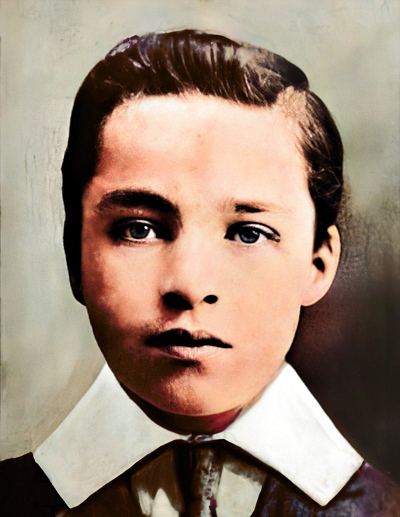 As there has been so much written on the life of Charlie Chaplin, this biography will largely focus on and take into context the parts of his life as a composer and musician, while still covering the major events and time line. Chaplin was not really a ragtime composer per se, but he did what he could to keep music viable in his films by directing the use of certain pieces or genres of pieces, and eventually composing them as well. Many of these works made it into print as far back as the mid-1910s, and a handful endure today. So his music was born out of the melding of ragtime and popular music as it accompanied early silent films, and therefore he should be not be ignored as a composer who drew on that era for some of his work. But he went well beyond that, as will be seen here, and should further be acknowledged for the boldness he displayed in scoring some of his later films as well, putting him also in the category of film composer.
As there has been so much written on the life of Charlie Chaplin, this biography will largely focus on and take into context the parts of his life as a composer and musician, while still covering the major events and time line. Chaplin was not really a ragtime composer per se, but he did what he could to keep music viable in his films by directing the use of certain pieces or genres of pieces, and eventually composing them as well. Many of these works made it into print as far back as the mid-1910s, and a handful endure today. So his music was born out of the melding of ragtime and popular music as it accompanied early silent films, and therefore he should be not be ignored as a composer who drew on that era for some of his work. But he went well beyond that, as will be seen here, and should further be acknowledged for the boldness he displayed in scoring some of his later films as well, putting him also in the category of film composer.Early Years
Charles Spencer Chaplin was born in England to Charles Chaplin and Hannah Hill, both performers in London music halls. Named after his father and his uncle, Spencer Chaplin, Charles had an older brother, Sydney (John Hill) Chaplin (1885), by a different father, whose identity has never been fully confirmed, but is considered by a handful of researchers to be a Sydney Hawkes.![The Girl Was Young and Pretty composed by Charles Chaplin [Sr.] and published in London c.1890 the girl was young and pretty sheet music](/images/youngandpretty.jpg) Charles Chaplin Sr. was a talented actor and singer, and even a published composer. One of his pieces was The Girl was Young and Pretty, the theme of which was later echoed in his 1992 film biography directed by Sir Richard Attenborough. Another was a poignant waltz song called Every-Day Life with lyrics by Harry Boden from 1891. The sheet music advertised that it had been "Composed and Sung with Enormous Success by Charles Chaplin." However, he was also an alcoholic, and ended up separating from Hannah when Charlie was around two. In the 1891 England census Hannah Chaplin is listed as an unemployed professional singer residing with Sydney and young Charles in the St. Mary district. Hannah showed as being married, but without her husband in the household. He was living nearby in the same district in a boarding house with other music hall artists.
Charles Chaplin Sr. was a talented actor and singer, and even a published composer. One of his pieces was The Girl was Young and Pretty, the theme of which was later echoed in his 1992 film biography directed by Sir Richard Attenborough. Another was a poignant waltz song called Every-Day Life with lyrics by Harry Boden from 1891. The sheet music advertised that it had been "Composed and Sung with Enormous Success by Charles Chaplin." However, he was also an alcoholic, and ended up separating from Hannah when Charlie was around two. In the 1891 England census Hannah Chaplin is listed as an unemployed professional singer residing with Sydney and young Charles in the St. Mary district. Hannah showed as being married, but without her husband in the household. He was living nearby in the same district in a boarding house with other music hall artists.
![The Girl Was Young and Pretty composed by Charles Chaplin [Sr.] and published in London c.1890 the girl was young and pretty sheet music](/images/youngandpretty.jpg) Charles Chaplin Sr. was a talented actor and singer, and even a published composer. One of his pieces was The Girl was Young and Pretty, the theme of which was later echoed in his 1992 film biography directed by Sir Richard Attenborough. Another was a poignant waltz song called Every-Day Life with lyrics by Harry Boden from 1891. The sheet music advertised that it had been "Composed and Sung with Enormous Success by Charles Chaplin." However, he was also an alcoholic, and ended up separating from Hannah when Charlie was around two. In the 1891 England census Hannah Chaplin is listed as an unemployed professional singer residing with Sydney and young Charles in the St. Mary district. Hannah showed as being married, but without her husband in the household. He was living nearby in the same district in a boarding house with other music hall artists.
Charles Chaplin Sr. was a talented actor and singer, and even a published composer. One of his pieces was The Girl was Young and Pretty, the theme of which was later echoed in his 1992 film biography directed by Sir Richard Attenborough. Another was a poignant waltz song called Every-Day Life with lyrics by Harry Boden from 1891. The sheet music advertised that it had been "Composed and Sung with Enormous Success by Charles Chaplin." However, he was also an alcoholic, and ended up separating from Hannah when Charlie was around two. In the 1891 England census Hannah Chaplin is listed as an unemployed professional singer residing with Sydney and young Charles in the St. Mary district. Hannah showed as being married, but without her husband in the household. He was living nearby in the same district in a boarding house with other music hall artists.To compound an already difficult situation, Hannah had some mental illness, and her inability to keep jobs required the broken family to move from place to place around Kensington Road, so as to be close enough to the theaters. Yet they still lived in relative comfort above the poverty level. Charles had constant exposure to the stage, and to the music as well. His mother, who worked under the name Lilly Harley, preferred to bring the boys to the theater rather than leave them alone, so they quickly became familiar with the songs of the day, bawdy and otherwise. They would occasionally see Charles Sr. perform as well, even after he had left the family. One of his frequent haunts was the Canterbury Music Hall.
As Charles relayed it in his autobiography, his first time on stage was when he was but five years old. He was backstage at the Aldershot Canteen while Hannah was performing for a group largely made up of soldiers. She was having a rough time of it, her voice cracking during her song. Whether Charles ventured out after she left the stage or whether he was pushed on remains conjecture or hearsay (he claims the latter). However, he took over for his mother, singing two or three songs, one of them being Jack Jones, and picking up coins thrown on stage by the amused audience in response to his work before he left. It was the start of a very long career performing for the public, and was claimed to be his mother's last night on stage.
Following this, Hannah, who had been prone to increasing bouts of laryngitis, was no longer able to work consistently as a singer, leaving the family of three suddenly living day to day in poverty. After a year or so they had to retreat to the workhouses, and at times were separated. Hannah recovered briefly, then had a breakdown. She was sent to Cane Hill Asylum at Coulsdon for recovery,
and Charles and Sydney were sent off initially to live with their father and his mistress Louise for a while. She, in turn, sent them to the Archbishop Temples Boys School, and had a tenuous relationship with Charles and Sydney. This was exacerbated by her drinking as well as their fathers, and the presence of a boy in the home who was four years younger. This was Charles' other half-brother, but he did not know it at that time. After a few months the boys went back again to live their mother after she was released. However, she was not able to properly care for them, and was again committed to the asylum while the boys were sent to a school for paupers. Sydney eventually went to sea and Charlie was at times out on the streets fending for himself.
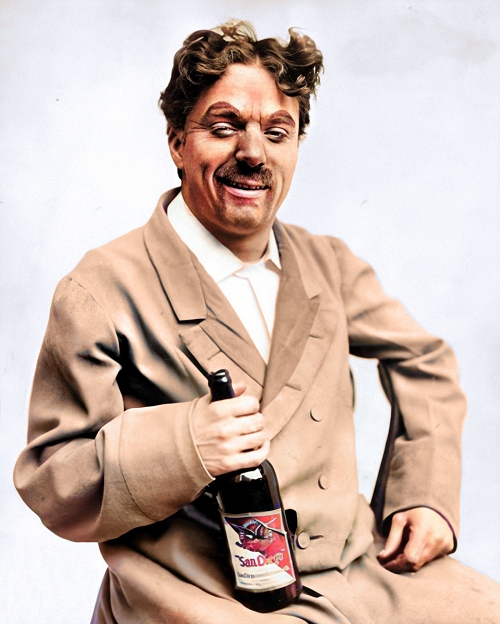 |
Even as a juvenile performer Chaplin claims he had not yet really discovered music. However, he told of that day in his biography, leaving the impression that he was perhaps eight at the time. Charles had come home to his father's empty house, and bored after a while he wandered out into the streets again to try to find food and solace. As he tells it: "Suddenly, there was music. Rapturous! It came from the vestibule of the White Hart corner pub, and resounded brilliantly in the empty square. The tune was The Honeysuckle and the Bee, played with radiant virtuosity on a harmonium and clarinet. I had never been conscious of melody before, but this one was beautiful and lyrical, so blithe and gay, so warm and reassuring. I forgot my despair and crossed the road to where the musicians were... It was all over too soon and their exit left the night even sadder... It was here that I first discovered music, or where I first learned its rare beauty, a beauty that has gladdened and haunted me from that moment."
Charles first worked as a billed artist in 1898 with a group of pre-teen clog dancers. They were called The Eight Lancashire Lads, and the experience allowed him to hone his agility of movement as well as gain a better sense of timing and rhythm in conjunction with the musical accompaniment. Although the work was necessary to help support his family, he was thoroughly at home on the stage, and became quite acrobatic as a result of his time as a dancer. He reportedly may have also done some singing and a little comedy with this act, but there is no direct billing that fully supports this contention. As of the 1901 England census he was rooming with a troupe of actors, possibly the clog dancers. Like the others, Charles was listed as a "music hall artiste." Neither his mother or Sydney were residing there, but he was one of ten juveniles living in the flat of John Jackson, son of the troupe's leader who himself was all of seventeen. That same year, Charles Sr. finally died at age 37 from cirrhosis of the liver and complications related to alcohol abuse.
At twelve and a half years of age after a year of odd jobs, and shortly after his mother was recommitted to Cane Hill, Charlie managed to snag a plum role in the C.E. Hamilton Company as Billie the Page Boy in a production of Sherlock Holmes. After getting good reviews in an otherwise poor play staged before the Sherlock Holmes tour, he continued in the role for three seasons. In the fourth season he ended up playing the same role opposite the author of the play. The four years emboldened him as an actor and established his stage presence, but not prepare him for comedy. Now sixteen and a bit cocky, Charlie decided to turn down the next role because it required traveling. As a result, he spent nearly a year not working.
Steady work of any kind was hard to come by, so he was supported in part by Sydney, who had been with British performer and producer Fred Karno's comedy company since 1906. Charles secured some music books and Jewish humor jokes, attempting to make a splash as an ethnic comedian. He was ill-prepared to do direct comedy as opposed to character comedy, and this venture lasted one performance. There were other minor failures on stage as well. Then at age nineteen Charlie, morally supported by Sydney, secured a position with Karno as a replacement actor playing opposite comedian Harry Weldon in a sketch called The Football Match.
Within a week he had a long-term contract with Karno, and his career as a comic actor was finally established.
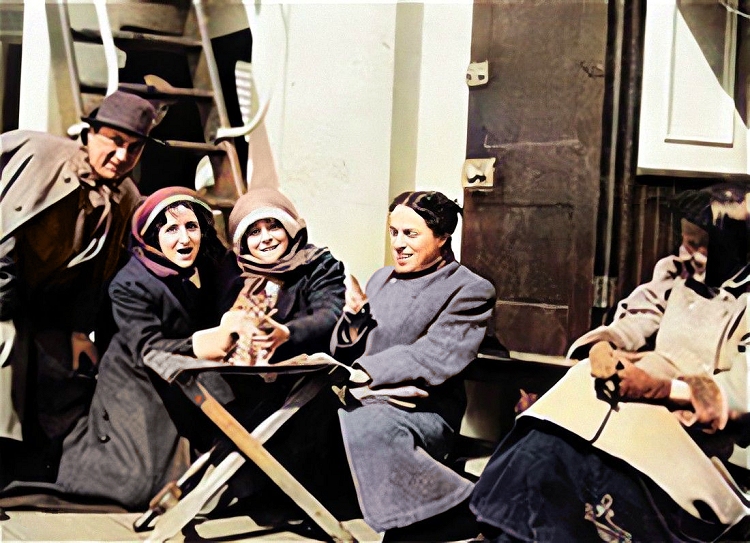 |
Working in various groups of Karno's traveling organization, Charlie quickly became a star of the sketch and pantomime comedy sketches, and his timing and choices were evidently highly regarded by the boss. It has been noted that his use of music in his act fully availed itself of the possibilities presented in the rhythmic and melodic elements of a tune, adding to the overall essence of his act. The acts often used classic 18th and 19th century melodies accompanied by sound effects or slapsticks to emphasize falls or other actions, which gave his form of comedy its name, even before he became associated with it. Among the actors he worked with during his time with Karno was another future comedy star, was Arthur Stanley Jefferson, known on stage as Stan Laurel. Stan ultimately served as Chaplin's understudy and backup while with the Karno company.
Charlie met a girl in the chorus line named Hetty Kelly and was instantly transfixed by her. His emotions for her became so strong that on their first outing he referred to her as his "nemesis," which she could not understand. Within days he had asked if she loved him, which she felt unfair given that Hetty was just short of sixteen to his nineteen years. Chaplin ended it right there after all of four encounters, but went to her home the following day to say goodbye once more just to be sure. He would never forget Hetty, and subconsciously would search for her over the next 34 years. In fact, when he met her just over a year later she was now seventeen and well-developed, but not the same girl in many ways, so he continued searching.
The Karno company toured Europe a couple of times from 1909 to 1910. At one show in Paris presented at the famous Folies Bergère, composer Claude Debussy was in the audience with a lady friend from the Russian ballet, and asked to meet Charlie after the show. The impressionist composer told him, "You are instinctively a musician and a dancer." While this was clearly a great compliment to Charlie, he was not sure how to reply, and he did not know who Debussy was at that time. However, he eventually knew all to well, noting in his autobiography it was the same year that "Debussy introduced his Prélude à L'Après Midi d'un Faune [Prelude to the Afternoon of a Faun] to England, where it was booed and the audience walked out."
Charlie toured Canada and the United States extensively with the American Karno company from late September 1910 to early 1912. They entered the United States on October 1 after having arrived a few days earlier to Quebec on the Cairnrona, and proceeded quickly to New York City for their first engagement of six weeks. Reports that he was the featured star entertainer with the troupe on that trip are not fully supported by newspaper advertising of that time until closer to the end of the tour, which was extended for twenty weeks to the west, another six in New York, and another twenty in the west again. Among the acts that toured was one titled The Wow Wows that featured Charles as "The Original Souse." In late 1912 the core of the Karno company again ventured to America to tour the vaudeville circuit for another year, arriving this time in New York Harbor on October 12 aboard the Oceanic as second class passengers.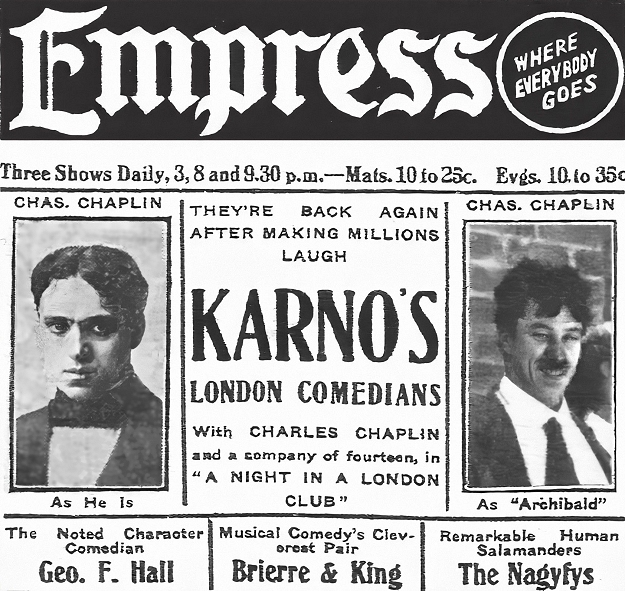 One of Chaplin's specialties in the Night in an English Music Hall sketch was playing an inebriated souse much older than himself, who randomly invaded the audience, then the stage, with his drunken antics.
One of Chaplin's specialties in the Night in an English Music Hall sketch was playing an inebriated souse much older than himself, who randomly invaded the audience, then the stage, with his drunken antics.
 One of Chaplin's specialties in the Night in an English Music Hall sketch was playing an inebriated souse much older than himself, who randomly invaded the audience, then the stage, with his drunken antics.
One of Chaplin's specialties in the Night in an English Music Hall sketch was playing an inebriated souse much older than himself, who randomly invaded the audience, then the stage, with his drunken antics.Stan Laurel remembered several facets of this second trip and recounted some information about Chaplin in a later interview with historian John McCabe. "Charlie carried his violin wherever he could. Had the strings reversed so he could play left handed, and he would practise for hours. He bought a cello once and used to carry it around with him. At these times he would always dress like a musician, a long fawn coloured overcoat with green velvet cuffs and collar and a slouch hat. And he'd let his hair grow long at the back. We never knew what he was going to do next." This concurs with Chaplin's own account of his first trip to the states: "On this tour I carried my violin and cello. Since the age of sixteen I had practised from four to six hours a day in my bedroom. Each week I took lessons from the theatre conductor or from someone he recommended. As I played left handed, my violin was strung left handed with the bass bar and sounding post reversed. I had great ambitions to be a concert artist, or, failing that, to use it in a vaudeville act, but as time went on I realised that I could never achieve excellence, so I gave it up."
It also during the second trip while they were playing in New York City that Chaplin went to the Metropolitan Opera House to see the opera Tannhäuser, something that may have influenced even more his sense of the melding of music and storytelling. According to Charlie: "I had never seen grand opera, only excerpts of it in vaudeville — and I loathed it. But now I was in the humour for it. I bought a ticket and sat in the second circle. The opera was in German and I did not understand a word of it, nor did I know the story. But when the dead Queen was carried on to the music of the Pilgrim's chorus, I wept bitterly. It seemed to sum up all the travail of my life. I could hardly control myself; what people sitting next to me must have thought I don't know, but I came away limp and emotionally shattered."
On the 1912 to 1913 trip Chaplin was clearly the star of the Karno troupe in their primary sketches, A Night in an English Music Hall and The Wow Wows. While on the second American tour, Charlie was witness to, and soon was entranced by the growing medium of motion pictures, now well into their second decade. The notion of putting something into a permanent record that could be viewed by potentially millions in a short time, as opposed to hundreds in a week, was appealing to him, as was the potential in what was a forced pantomime. So near the end of 1913 when his contract with Karno expired, Chaplin decided to achieve his own success in America and left the company to pursue a career in the movies.
The Cinema and Rise to Fame
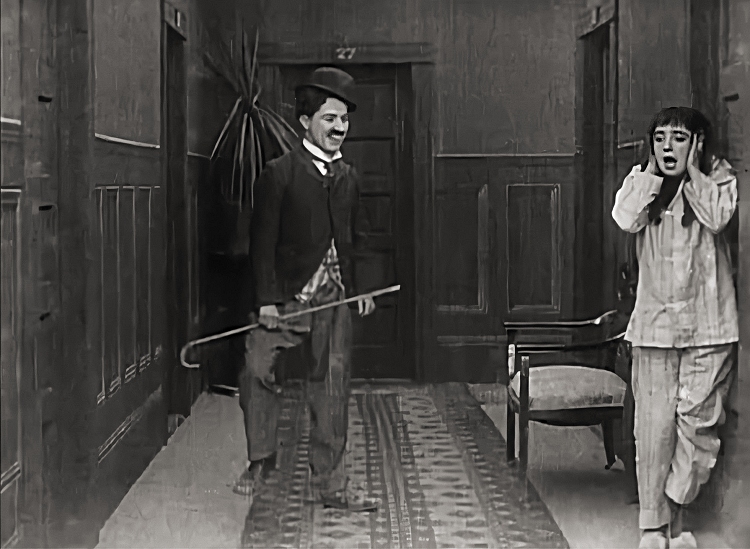 |
Actress Mabel Normand took up Charlie's cause and insisted that Sennett give him another chance under her tutelage. Although he had issues with a woman directing his acting, Chaplin persevered and came back strong in the next film, Mabel's Strange Predicament.. According to his autobiography Sennett had asked him to dress in a comedy make up of some kind. The famous incident with him finding his new identity was poetically recreated in the 1992 biopic Chaplin starring Robert Downey Jr., but Chaplin's own passage was actually a bit more practical:
I had no idea what makeup to put on. I did not like my get-up as the press reporter [in the previous film Making a Living]. However on the way to the wardrobe I thought I would dress in baggy pants, big shoes, a cane and a derby hat. I wanted everything to be a contradiction: the pants baggy, the coat tight, the hat small and the shoes large. I was undecided whether to look old or young, but remembering Sennett had expected me to be a much older man, I added a small moustache, which I reasoned, would add age without hiding my expression. I had no idea of the character. But the moment I was dressed, the clothes and the makeup made me feel the person he was. I began to know him, and by the time I walked on stage he was fully born...
[Sennett] stood and giggled until his body began to shake. This encouraged me and I began to explain the character: 'You know this fellow is many-sided, a tramp, a gentleman, a poet, a dreamer, a lonely fellow, always hopeful of romance and adventure. He would have you believe he is a scientist, a musician, a duke, a polo-player. However, he is not above picking up cigarette-butts or robbing a baby of its candy. And, of course, if the occasion warrants it, he will kick a lady in the rear — but only in extreme anger!'"
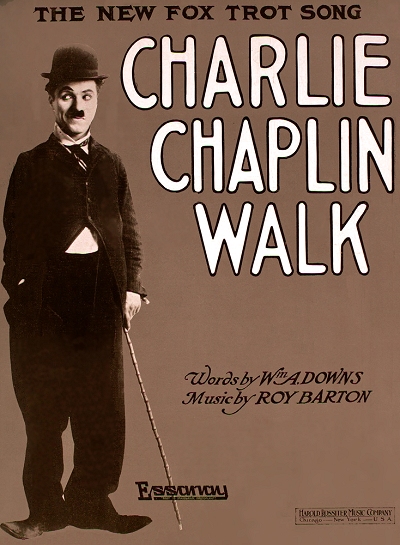
In reality, the hat and oversized pants came from the rotund Arbuckle and the shoes from Ford Sterling. The concept itself was evocative of his early years living in poverty and making due with whatever was at hand. While the tramp did appear briefly in Mabel's Strange Predicament, the first film that featured that character, shot the following week, was Kid Auto Races at Venice released in early February 1914. The simple plot had him mugging annoyingly for the camera at a soapbox derby race while directors and cameramen try to keep him out of the picture. The tramp character immediately caught on with audiences, and several more shorts were made featuring Chaplin. He immediately adopted the oversized shoes, baggy pants, and penguin-like walk that made him stand out. Charlie did play a Keystone Kop in one recently discovered short, but once the tramp character was established he rarely veered away from his creation. Little known to most of the public, the tramp also had a name, the French derivative of his own, Charlot.
By the middle of the year Chaplin shorts were drawing crowds, and they were appearing frequently in advertising, often trumping the feature they were playing with. It was clear to Sennett and Chaplin that $150 per week was hardly appropriate any more, and the two tussled over numbers for the remainder of the year. Chaplin also wanted more control over scenarios, editing, and even directing. He was now making $175 per week plus a $25 bonus for each completed film. Sennett and Chaplin were often at odds, but the studio head put up with it because his revenues had increased significantly thanks to Charlie's films. Even before the end of 1914, Chaplin was the most famous movie comedian, and arguably the most famous comic actor in the United States. During his one year contract Charlie appeared in 36 Keystone films, a brutal pace considering the amount of physical action and location shooting done in the early days of film.
It was a show of respect by Sennett that he did not openly contest Chaplin leaving his organization to work for Essanay Studios (S and A for owners George K. Spoor and cowboy star G.M. "Bronco Billy" Anderson) in 1915 for a great deal more money.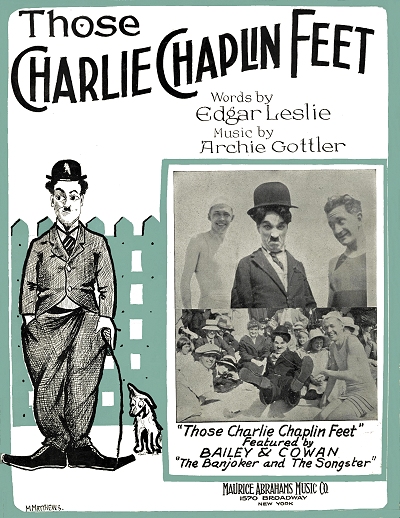 News reports of the time put it at over $100,000 for the year. By then, Sydney had also come to the United States, and for a time replaced his brother in Keystone comedies. At Essanay Charlie was given a bit more freedom to develop his gags, and regularly used a stock set of actors for consistency. Among them was a young lady named Edna Purviance and villains Bud Jamison and Leo White. Essanay managed to distribute Chaplin films to every corner of the country and heavily advertised their star property as well. Chaplin films even managed big draws in New York City, where entertainment was available at every turn. However, much of the crowd seeking entertainment from the tramp were immigrants who still did not have command of the English language, and did not really need to in order to grasp the universal pantomime slapstick that Charlie was mastering.
News reports of the time put it at over $100,000 for the year. By then, Sydney had also come to the United States, and for a time replaced his brother in Keystone comedies. At Essanay Charlie was given a bit more freedom to develop his gags, and regularly used a stock set of actors for consistency. Among them was a young lady named Edna Purviance and villains Bud Jamison and Leo White. Essanay managed to distribute Chaplin films to every corner of the country and heavily advertised their star property as well. Chaplin films even managed big draws in New York City, where entertainment was available at every turn. However, much of the crowd seeking entertainment from the tramp were immigrants who still did not have command of the English language, and did not really need to in order to grasp the universal pantomime slapstick that Charlie was mastering.
 News reports of the time put it at over $100,000 for the year. By then, Sydney had also come to the United States, and for a time replaced his brother in Keystone comedies. At Essanay Charlie was given a bit more freedom to develop his gags, and regularly used a stock set of actors for consistency. Among them was a young lady named Edna Purviance and villains Bud Jamison and Leo White. Essanay managed to distribute Chaplin films to every corner of the country and heavily advertised their star property as well. Chaplin films even managed big draws in New York City, where entertainment was available at every turn. However, much of the crowd seeking entertainment from the tramp were immigrants who still did not have command of the English language, and did not really need to in order to grasp the universal pantomime slapstick that Charlie was mastering.
News reports of the time put it at over $100,000 for the year. By then, Sydney had also come to the United States, and for a time replaced his brother in Keystone comedies. At Essanay Charlie was given a bit more freedom to develop his gags, and regularly used a stock set of actors for consistency. Among them was a young lady named Edna Purviance and villains Bud Jamison and Leo White. Essanay managed to distribute Chaplin films to every corner of the country and heavily advertised their star property as well. Chaplin films even managed big draws in New York City, where entertainment was available at every turn. However, much of the crowd seeking entertainment from the tramp were immigrants who still did not have command of the English language, and did not really need to in order to grasp the universal pantomime slapstick that Charlie was mastering.Charlie had another trick up his sleeve as well, making an attempt at a popular song in 1915.He sought to have his music heard in America. When Oh! That Cello was self-published in 1915 it had a slow start. But after a piano roll of it was released the following year the name association caused some head scratching and curiosity in the music industry, as reported in The Music Trade Review of September 9, 1916.
CONSIDERABLE anxiety has been expressed in various quarters to know whether the Charles Chaplin who appears as the composer of "Oh that 'Cello" in the August bulletin of the Q R S Co. is in reality he of the slap-stick motion picture comedy fame. The Q R S Co. aver that it is the simon pure Charles. He is doing quite a bit of composing nowadays between acts, so to speak, and moreover is publishing his own compositions. "Oh that 'Cello" is quite pleasing even to the ear of one who does not revel in the popular music of the day. Lee Roberts [main arranger and vice president of QRS] made a hand played roll of it and has a nice letter from the real Charles written from Los Angeles giving his permission for its inclusion in the Q R S catalog.
Even before the discovery that Chaplin was a composer, composers discovered Chaplin, and in 1915 alone no less than eight pieces named for Charlie or his feet were in the stores. The most popular of them were That Charlie Chaplin Walk and Those Charlie Chaplin Feet.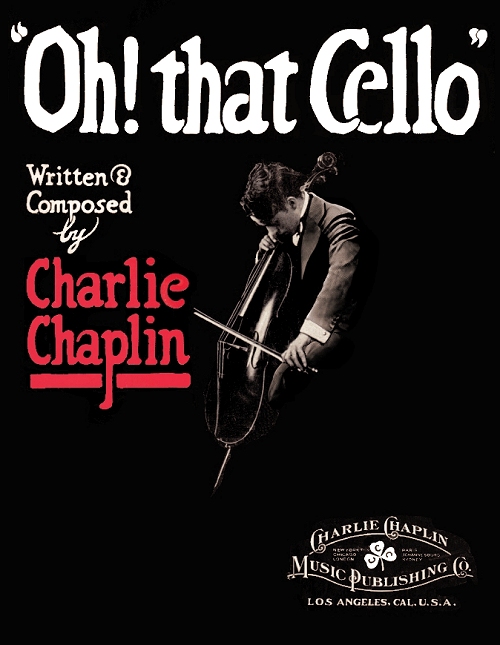 The reason such a comic association between music and Chaplin's screen persona seemed so natural is that it often was. Chaplin, like many other fine comic actors, knew that there were layers of rhythm within the concept of "comic timing." Even today, scripts for television and movies often use the term "take a beat" or "two beats" at times, informing the actor to pause for an amount of time that would be analogous to the current pace of the action. Sennett often had musicians in his employ to provide not only mood music but rhythm to help the flow of action for the actors.
The reason such a comic association between music and Chaplin's screen persona seemed so natural is that it often was. Chaplin, like many other fine comic actors, knew that there were layers of rhythm within the concept of "comic timing." Even today, scripts for television and movies often use the term "take a beat" or "two beats" at times, informing the actor to pause for an amount of time that would be analogous to the current pace of the action. Sennett often had musicians in his employ to provide not only mood music but rhythm to help the flow of action for the actors.
 The reason such a comic association between music and Chaplin's screen persona seemed so natural is that it often was. Chaplin, like many other fine comic actors, knew that there were layers of rhythm within the concept of "comic timing." Even today, scripts for television and movies often use the term "take a beat" or "two beats" at times, informing the actor to pause for an amount of time that would be analogous to the current pace of the action. Sennett often had musicians in his employ to provide not only mood music but rhythm to help the flow of action for the actors.
The reason such a comic association between music and Chaplin's screen persona seemed so natural is that it often was. Chaplin, like many other fine comic actors, knew that there were layers of rhythm within the concept of "comic timing." Even today, scripts for television and movies often use the term "take a beat" or "two beats" at times, informing the actor to pause for an amount of time that would be analogous to the current pace of the action. Sennett often had musicians in his employ to provide not only mood music but rhythm to help the flow of action for the actors.Chaplin sometimes did the same, and he also knew the importance of both acting and editing in such a way that music played to his films, the big end factor over which he had virtually no control over at that time, would naturally find a sweet spot through his pacing. Many of the songs about Chaplin fit that mold nicely, and were not only used to accompany some of his films but sold in the lobbies as well. Others were featured on stage, managing to make the presence of Charlie known even at the popular Ziegfeld Follies. Chaplin himself made it known that certain popular piece might even inspire action sequences or scenarios. "Simple little tunes gave me the image for comedies. In one called Twenty Minutes of Love, full of rough stuff and nonsense in parks, with policemen and nursemaids, I weaved in and out of situations to the tune of Too Much Mustard, a popular two step in 1914. The song Violetera set the mood for City Lights, and Auld Lang Syne the mood for The Gold Rush."
Chaplin's first Essanay film was made at their Chicago headquarters, a place he deplored. So he went to their studio in Niles, California, which was situated near the San Francisco Bay area and featured very usable old-west scenery. During the process of making his fourteen films at Essanay Charlie's musical proclivities became better known to his colleagues. He bought a higher quality violin, perhaps favoring it over the cello. It was said that he would "scrape away" at the instrument for several hours at night. As he and the other actors were often housed next to the studio at Niles, Chaplin staying in the surprisingly sparse quarters of millionaire Bronco Billy, they would often suffer through sleepless nights listening to Chaplin trying to master the instrument. That misery did not last long. After four more films Chaplin retreated to Southern California and rented a studio near downtown Los Angeles for the remaining Essanay films.
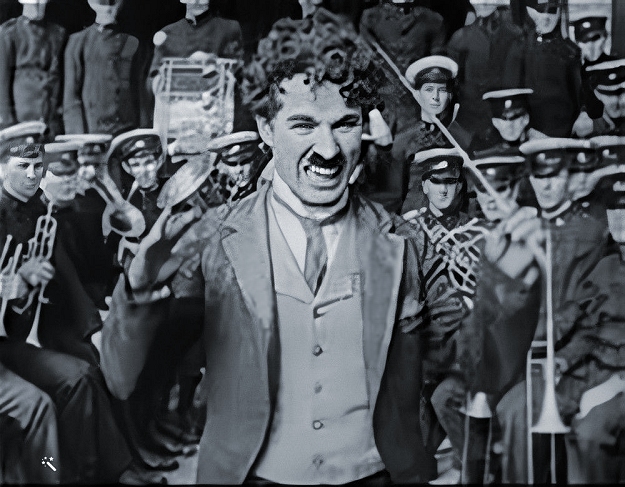 |
After a successful but sometimes choppy run with Essanay in 1915, Sydney arranged a lucrative agreement for his brother for $670,000 ($10,000 per week plus a $150,000 signing bonus) with the Mutual Film Corporation for twelve two-reel comedies in 1916, one per month. Mutual wisely gave him more or less carte blanche in terms of artistic control, content and personnel. The same was true in terms of time, because as the Mutuals went along Chaplin required a longer shooting and editing schedule. The initial twelve months stretched into just over eighteen. However, every one of the twelve films has remained a classic for nearly a century, and Chaplin stated in his autobiography that it was the most productive and happiest period of his career.
Mutual allowed Chaplin to form his own separate production arm named Lone Star Productions. In spite of his success with the tramp, the character was not featured in all of these shorts. In The Fireman he is obviously a fireman in and The Cure Chaplin plays an alcoholic who checks into a sanatorium. One of most unique Mutuals, One A.M., features Chaplin as an adventurous bachelor who arrives home quite inebriated and has to negotiate the hazards of his own home in order to get to bed, or something like a bed. There is a clear rhythmic pace in this solo effort that is punctuated by a wall clock with an oversized widely swinging pendulum. In The Vagabond he played a saloon violinist who rescues a girl from a cruel gypsy master. In it he is seen playing in his usual left-handed manner. The Rink, Easy Street and The Pawnshop have also remained favorites.
Chaplin's new role as a comic leading man opened many doors to him, but also brought obligations. He was asked to do benefits and promote causes.
In one instance he did a benefit at the famous Hippodrome in New York City. A filmed snippet remains that is thought to be from that benefit. It shows Chaplin in his guise as a musician, conducting the band half seriously while clowning around with them. Even though the appearance was staged, it had an air of spontaneity and joy. His fame also brought him many visitors and admirers. Among those wer two men that Chaplin himself had admired for some time, pianists Ignace Jan Paderewski and Leopold Godowsky, the latter who posed with Charlie in late 1916. There is no account of any lessons being given in either music or comedy during that visit. Chaplin also built up a fine ensemble cast and crew. In addition to his leading lady and constant companion Edna Purviance, who he was romantically involved with during 1916 and 1917, he brought in his half-brother Sydney as both agent and manager, and added a comic giant villain, Scottish import Eric Campbell, to his stock company. Charlie had known the 6'4" Campbell from the Karno company, and he was described as a very gentle giant. During the Mutual run Campbell lost his wife to sickness, and subsequently got involved in a sham marriage. Sadly, after the last Mutual production was finished, Eric died instantly in a tragic car accident on Wilshire Blvd. in December 1917, the result of too much alcohol.
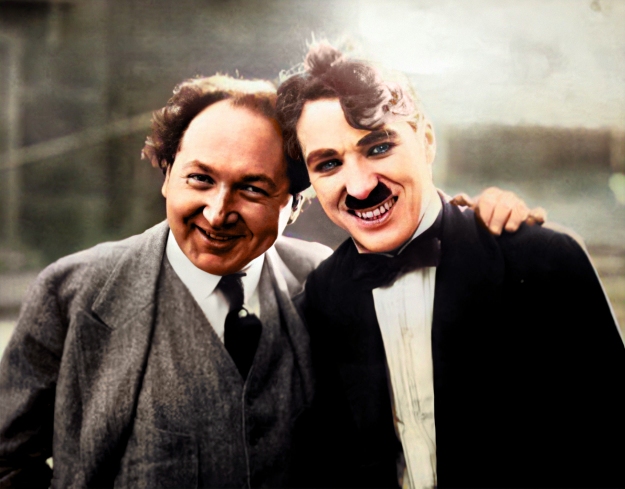 |
To further extend his control over his end products, Charlie had formed the Charles Chaplin Music Company with comedian and pianist Bert Clark to publish Oh! That Cello. He likely had big plans for that concern, but in its short life of perhaps two months or so only two more pieces were published. The Peace Patrol was a simple but lyrical instrumental march.
While he was negotiating with the Mutual Company in New York City, Chaplin appeared at a benefit concert at the Hippodrome on February 20, 1916. There he led Sousa's band in the Poet and Peasant Overture, followed by The Peace Patrol, perhaps its only public performance in his lifetime. This composition was followed by There's Always One You Can't Forget, a sentimental piece about his first true love, Hetty Kelly. (In 1921 he found out that Hetty had died during the flu pandemic which devastated him.) As for his publishing activities, Chaplin recalled that, "[Bert and I] had rented a room three storeys up in a down town office building and printed two thousand copies of two very bad songs and musical compositions of mine — then we waited for customers. The enterprise was collegiate and quite mad. I think we sold three copies, one to Charles Cadman, the American composer, and two to pedestrians who happened to pass our office on their way downstairs."
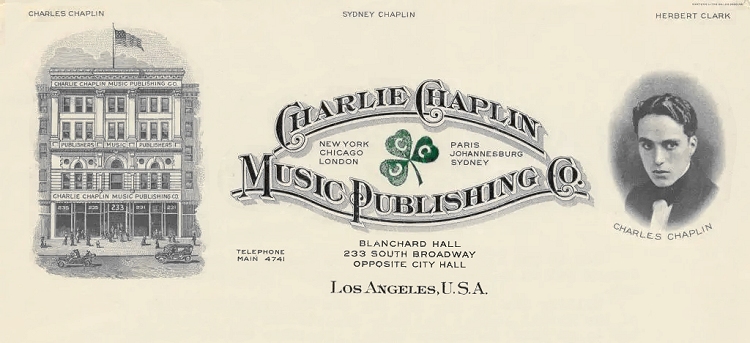 |
In the latter half of 1917 after nearly 18 months, Charlie left Mutual, where he later said he had enjoyed the best period of his life. He signed with First National for a contract of eight two-reel films (some would be longer). The money and freedom they gave him in addition to what he had earned from Mutual allowed Chaplin to build his own studio in Hollywood (presently the home to Disney's Jim Henson Studios). Chaplin remembered that "At the end of the Mutual contract, I was anxious to get started with First National, but we had no studio. I decided to buy land in Hollywood and build one. The site was the corner of Sunset and La Brea and had a very fine ten-room house and five acres of lemon, orange and peach trees. We built a perfect unit, complete with developing plant, cutting room, and offices." He met with resistance from a local residential neighborhood who opposed the encroachment, but ultimately was allowed to built by the city council. Sydney also joined him in this effort, becoming Charlie's manager.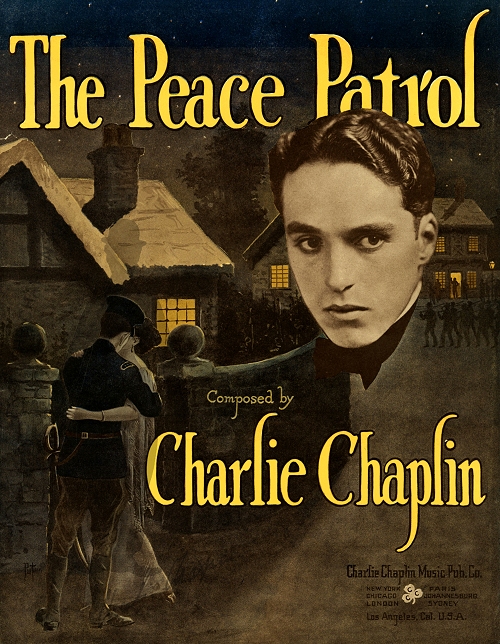 He played a comic role of a food vendor in Chaplin's first film for the company, A Dog's Life, released in 1918.
He played a comic role of a food vendor in Chaplin's first film for the company, A Dog's Life, released in 1918.
 He played a comic role of a food vendor in Chaplin's first film for the company, A Dog's Life, released in 1918.
He played a comic role of a food vendor in Chaplin's first film for the company, A Dog's Life, released in 1918.From the time of the Great War (World War I) on there was some obvious controversy concerning Chaplin's patriotism towards the United States, more a reflection of his perceived political views than anything. One that persisted was that he tried to avoid the draft or enlistment. This is not true, and he indeed filled out a draft card on June 5, 1917, listing himself as moving picture comedian working for the Lone Star Company, the name of the production company he had formed at Mutual. In fact, it has been reported that Chaplin made three attempts [at least two confirmed] to enlist in either the American or British armies, and was rejected for one or another reason. At 5'6" and a mere 125 pounds he was a bit slight to be a soldier. Even though he was not a naturalized citizen, that fact did not make him ineligible. He had wanted to enlist in the British Army, but his Mutual contract stipulated that he remain the United States until it was fulfilled. Not knowing this, soldiers in the British army adopted a nasty parody, sung to Red Wing by Kerry Mills, called The Moon Shines Bright on Charlie Chaplin, suggesting he be sent to the Dardanelles where a bloody campaign had taken place.
It is known that Chaplin was seen as an important entity in his capacity as an actor, as he was not yet involved with so-called subversive organizations or activities. He was also quite active in promoting the sale of bonds during a national tour with Mary Pickford, best friend Douglas Fairbanks, and actress Marie Dressler. This was followed by a short called The Bond, made at his own expense, which was used by the Federal Government to further promote sales. It explained several types of bonds, including friendship and marriage, ending with the most important type, Liberty Bonds. A final scene showed him wielding a larger mallet with "Liberty Bonds" painted on it, which he used to successfully pummel the Kaiser (played by Sydney), in a comical manner, of course. One of his early films through First National was the war-themed feature Shoulder Arms, which was a large success at the box office and considered by historians to be the best World War I film actually during the conflict. In it, Sydney reprises his role as the much abused Kaiser.
By mid 1917, most theaters in the United States had house musicians playing either piano or organ, or in some cases ensembles ranging from three piece groups to orchestras. In smaller towns it would often be a piano teacher or her star student playing classical tunes or the latest popular songs and rags to the films for some extra cash. For the most part, with few exceptions, there were no definitive music scores for movies, especially for the shorts.
D.W. Griffith had commissioned scores for a couple of his feature films, but they were typically only used in the very largest metropolitan centers and not reduced to a piano or organ score. The following year would see the introduction of theme songs associated with films, but one song a score did not make.
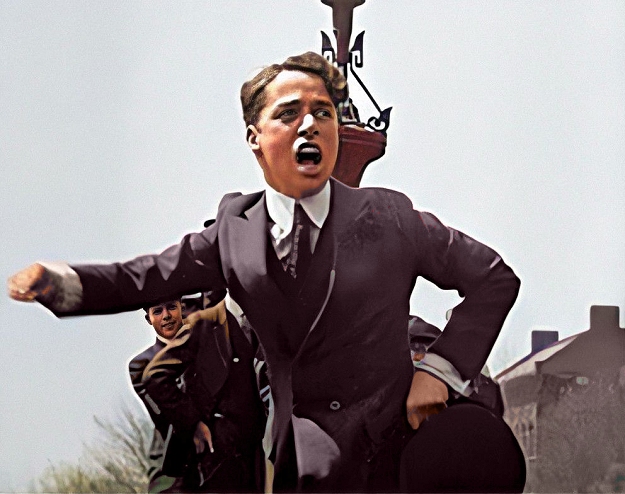 |
Chaplin was well aware of this shortfall, and in particular recognized how the proper underscore would add to the emotional import of the action on the screen. Along with some other directors and producers his company sent out simple suggestions for the type of music to play for each scene, even with some popular titles. While this was not the same as a score, the guidance provided more consistency for film goers as long as the local musicians were capable of following these directions.
The first hint of coming disasters in his life came about in 1918 when Charlie, then 29, married a popular 18-year-old actress, Mildred A. Harris, a quickly formed union predicated on a pregnancy that turned out to be a false alarm. While their relationship seemed to be smooth at the start, things quickly fell apart after Mildred actually did get pregnant, then gave birth to a son, Norman Spencer Chaplin. Sadly, the child died at three days old on July 10, 1919. The couple was never able to fully reconcile, and Charlie set out on a series of affairs that occasionally made it into the press, not helping his image or his questionable marriage.
Being a top personality in show business, his endorsement was sought out by many companies, one comical example which was relayed in The Music Trade Review of December 21, 1918:
Charlie Chaplin received a letter from a certain manufacturer of musical instruments, proposing to present him with a saxophone providing he would be photographed with it, and permit the maker to use the indorsement [sic] for advertising purposes. Not being particularly interested in the saxophone but appreciating the gentleman's courtesy, Mr. Chaplin in part replied: "If you happen to have a spare 'Strad' violin knocking about that you don't want, well, you might send it on. I will have my picture taken with it, and I will give you a letter to the effect that I can thoroughly recommend it."
On February 5, 1919, with his new studio fully built and in production for a year now, Charlie joined one of the earliest ongoing efforts to promote individualistic freedom and support for film makers. Along with Sydney and their actor friends Mary Pickford (America's sweetheart), Douglas Fairbanks (America's screen hero), William S. Hart (America's favorite cowboy) and legendary director David W. Griffith, the group formed the United Artists production and distribution company. They had heard, in part through a woman detective they had hired, that some of the larger studios and distributors were banding together, which would have created a monopoly in the business, with little of the money going to the artists.
As was Chaplin's hope, the idea behind this organization was to allow the stars to be their own bosses. Through UA they had to do their own financing for projects, but they also were able to reap more of the profits, which had traditionally gone to the producers of films. Yet at the time he helped form the organization, Charlie still had an obligation of six films to complete with First National in order to exercise that freedom. Charles and Mildred appeared in the 1920 census living 674 Oxford Way in Beverly Hills with a live-in chef and his wife. They both listed their occupation as a motion picture actor and actress respectively.
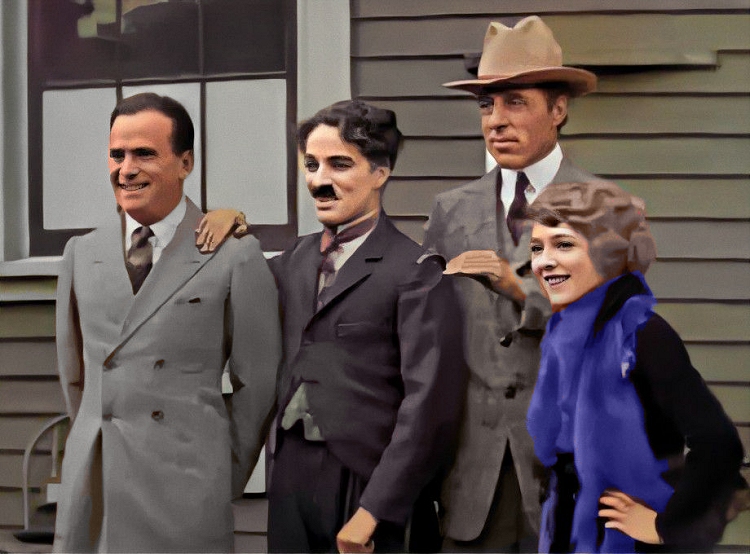 |
In 1919 he completed two more films, the unusual three reel Sunnyside and the more traditional two rell A Day's Pleasure, the latter of which included several potential vomiting jokes. His next film for them was a six-reel feature, The Kid, starring child actor Jackie Coogan (who would later act as Uncle Fester on The Addams Family) along with Chaplin. Much more than a comedy it went through a variety of emotions including tragedy, sentiment and pure pathos. Charlie wanted this particular release to have something more attached to it. So The Kid was distributed with fairly specific cue sheets with title lists, and in some packages music as well. While this was not a Chaplin score per se, it helped him realize something much closer to the overall intent and emphasized the importance in which he held music as an important entity and even a character in his films. Joe Bren and Haven Gillespie wrote a song specifically for the film, but there is some uncertainty as to whether this piece was included in the official recommendations.
There may have been more music composed during the final stages of the film, but Charlie would not have time to tend to that. Mildred had filed for divorce and was reportedly attempting to seize his assets. In the process she had also publicly accused him of being a "red," or a Bolshevist sympathizer, the first time he would have to counter such a charge. Charlie had already moved out and was living in the Los Angeles Athletic Club, rather than at the apartment he had built at his studio. He had stirred the waters by suggesting that Harris was engaging in lesbian activities with other young actresses. Concerned that the authorities may move in, in the middle of the night Chaplin grabbed all of the film stock from The Kid and with Sydney's assistance moved it to a hotel room in Salt Lake City, Utah, where the editing was completed by Charlie himself. Upon the discovery that he was in Utah, where the authorities did not arrest or extradite him, one newspaper article observed of the 31-year-old star that "Charlie's hair is growing gray." Even without the full suggested score that he had hoped to assemble for the premier events, the movie was a huge hit and his reputation was kept intact. Mildred ended up with some of their joint property and a $100,000 settlement in November 1920. She would overspend and be bankrupt within two years.
Needing a break after the traumatic events involving The Kid, and the efforts involved in his next film, The Idle Class, in which he played two roles, Charlie sailed for England on the Olympic in late August, 1921, arriving in Southampton, England, on September 1. While he was aware he had achieved some level of fame on the continent and in his original home of London, Chaplin was quite awe struck and moved by the reception he received there. He also met with author H.G. Wells, but his hopes for a private meeting were dashed by the large crowds hanging around their rendezvous point.
There were also some dissenters in London who had misunderstood his role in the Great War, so he ended up more or less escaping his original home and the mix of joy and angst he found there.
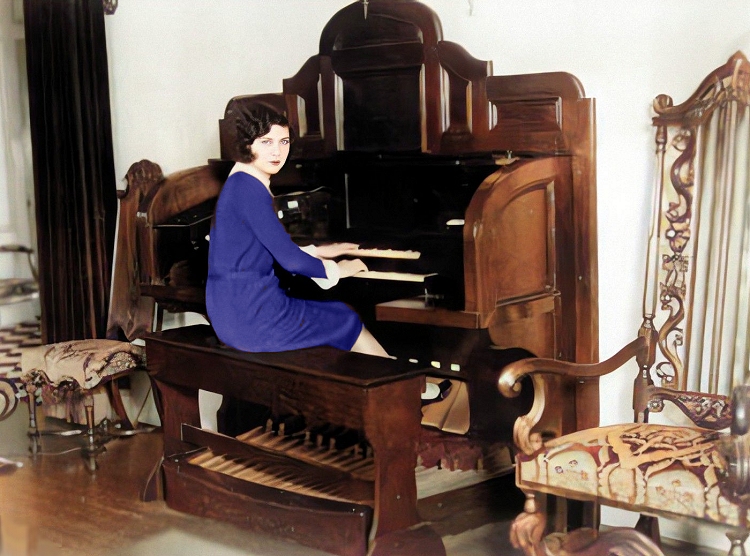 |
He left for Paris, then Berlin, and there met with Albert Einstein and his wife. Everywhere he went Charlie was met by large crowds who revered his talent, and underscored how universal his pantomime comedy, which transcended language barriers, actually was. Back in Paris Charlie reluctantly appeared at a benefit showing of The Kid, then retreated back to London. There he was able to spend more time with Wells and a number of British dignitaries who sought an audience with him. After a seven week vacation, Chaplin returned to New York, then Hollywood to resume his work with new energy. On the returning passenger list on the Berengaria, dated October 17, 1921, his nationality is listed as English. However it was apparently and inaccurately altered on February 7, 1936, with English written over with Hebrew for unknown reasons.
Chaplin made two more films to finish off his First National contract, Pay Day and The Pilgrim. While there was no specific score composed for these at that time (some of his early films would be scored in later years by Chaplin), they were accompanied by the same sort of cue sheets as had been sent out with The Kid. But as his films progressed, he was already experimenting more with composition, and in his leisure time was engaged ever more with performance.
Having made his first million and more, Charlie first procured a Brambach Welte-Mignon reproducing piano in late 1919. In 1922 he bought a Bilhorn Telescope Organ, a portable device that allowed him to take his music on the set with him. Chaplin then had an expensive Robert-Morton Pipe Organ installed in his new Beverly Hills mansion as it was being built in 1923. It was reported that he often sat at it for hours at a time playing older melodies and composing new ones. The procurement of the instrument was described in the music trade magazine Presto on February 3, 1923:
Movie fans in the country seldom realize the true character of their screen stars. Screen action, plot, and the vehicle representing our favorite doesn't always fully interpret the temperament of the actor.
It may be news to many readers that Charlie Chaplin is a clever musician, playing violin, piano and organ with unusual skill. The first intimation that many of Chaplin's friends and followers knew of this musical talent was the placing of an order for a Robert-Morton organ to be installed in his new [Beverly Hills] home in the course of construction. This is one of the finest, residences in the Hollywood district. In the music room provision was also made for an echo organ and a special roll device will also be installed on the instrument.
It is expected that Charlie will "shoulder arms" over the console of the new instrument when the Pipes of Pan are playing in the springtime.
Now one of the richest entertainers in the world, Chaplin was certainly enjoying and reveling to some degree in the spoils, which sent a mixed message to some fans and critics. In the September 2, 1922 Music Trade Review, Los Angeles music columnist Marshall Breeden made the observation that Chaplin had once "told this writer that in the early days of his stage life, and later in pictures, he strove to be artistic. He did not look only for the money. Now to him money comes, but he certainly is the one outstanding man in the world who comes closest to the border line between comedy and tragedy." In many ways those words were predictive as well.
Creativity and Chaos
In 1923 Charlie was free from First National, and ready to start on his contract signed with his own collective company, United Artists. With ready financing, his own studio, and the support of many of his peers, he was finally afforded the freedom to make films on his terms and his schedule. It would take nineteen years for him to fulfill his eight film contract, but they included his four most notable masterpieces, all of which had scores by the director and star as well.
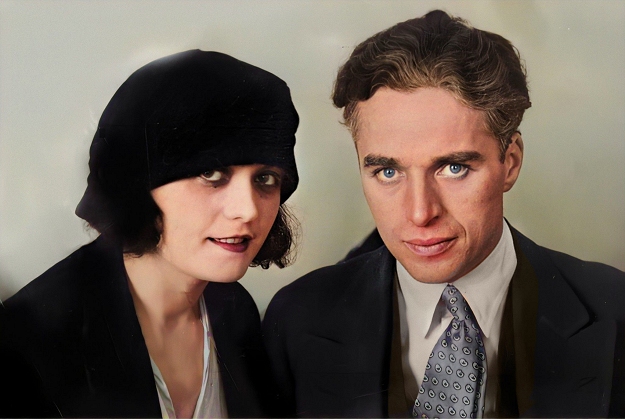 |
His first effort with UA in 1923 was A Woman of Paris. Unlike his previous films, this one was a romantic drama, not a comedy, and while it was written and directed by Chaplin, he only appeared in it for a few seconds. It was in part a vehicle for his long time leading lady and former romantic partner, Edna Purviance, to help her launch a dramatic career. But by this time Chaplin was already involved with other partners, including serial millionaire divorcée Peggy Hopkins Joyce who had inspired the film. While A Woman of Paris was received very well by the critics and his peers, the public did not seem to care for it very much, and it did poorly at the box office. There was no specific score known to exist when the film was first released, just the cue sheets. However, A Woman of Paris would be the very last film he would score at age 86, when he went into the studio with his arranger, Eric James, and tried to breathe new life into the movie with appropriate music.
There was again some trauma in his life while working on A Woman of Paris. After a number of affairs, he became involved with a Polish actress named Pola Negri. While he had managed to keep many of the earlier dalliances off the radar, the relationship with Negri, which allegedly included a one month engagement that was most likely contrived by the press, became quite public. Whether this was for publicity purposes or not has not been ascertained for certain, but many aspects of Pola's time in the United States clearly were dramatized for public consumption. At the same time that Mildred announced her intentions to remarry, she also lashed out at Charlie and Pola, calling their romance "funny," and that he would never the same after the "marital lessons I taught him." The stormy relationship ended after the engagement debacle, with Negri feigning major heartbreak.
This was followed by an alleged affair with actress Marion Davies, who was known to have been involved with newspaper magnate William Randolph Hearst. In the end she stayed with Hearst, but their affair allegedly resurfaced a few times through the early 1930s. False stories have persisted concerning Chaplin and Davies, stating they were involved in the murder of Charlie's friend, film producer Thomas Ince, on Hearst's yacht on November 18, 1924, when Hearst mistook Ince for Chaplin and shot him a jealous rage. The supportable facts that put this falsehood are that the relationship between Chaplin and Davies is hard to pin down, Chaplin was confirmed to have not been on the yacht that weekend, and that Ince actually died from a heart ailment a day after being removed from the yacht with a case of acute indigestion. Chaplin's aid and chauffer Kono reportedly claimed that Ince was bleeding from a bullet wound to the head when he was brought off the yacht. The case was closed even before the persistent rumors took hold. It harmed Hearst's career, but not Chaplin's.
Chaplin's next film, one of the masterpieces, was inspired by the tales of the men who in the winter of 1897-1898 braved the cold and brutal Klondike,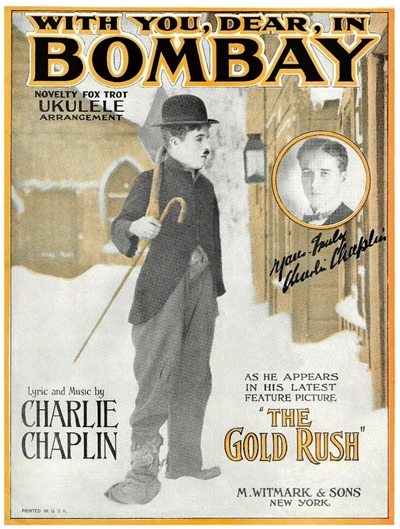 having scaled either Chilkoot Pass or White Pass into Canada with the hope of finding gold in the fields near Dawson several hundred miles downstream. The Gold Rush would start out with a legendary shot recreating the treacherous climb up Chilkoot Pass, filmed near Truckee in Northern California, and using a deft combination of comedy and pathos, told the story of a simple and unfortunate tramp miner who eventually earned his keep, even though he seemed to have lost the girl of his dreams.
having scaled either Chilkoot Pass or White Pass into Canada with the hope of finding gold in the fields near Dawson several hundred miles downstream. The Gold Rush would start out with a legendary shot recreating the treacherous climb up Chilkoot Pass, filmed near Truckee in Northern California, and using a deft combination of comedy and pathos, told the story of a simple and unfortunate tramp miner who eventually earned his keep, even though he seemed to have lost the girl of his dreams.
 having scaled either Chilkoot Pass or White Pass into Canada with the hope of finding gold in the fields near Dawson several hundred miles downstream. The Gold Rush would start out with a legendary shot recreating the treacherous climb up Chilkoot Pass, filmed near Truckee in Northern California, and using a deft combination of comedy and pathos, told the story of a simple and unfortunate tramp miner who eventually earned his keep, even though he seemed to have lost the girl of his dreams.
having scaled either Chilkoot Pass or White Pass into Canada with the hope of finding gold in the fields near Dawson several hundred miles downstream. The Gold Rush would start out with a legendary shot recreating the treacherous climb up Chilkoot Pass, filmed near Truckee in Northern California, and using a deft combination of comedy and pathos, told the story of a simple and unfortunate tramp miner who eventually earned his keep, even though he seemed to have lost the girl of his dreams.Wanting even more control over the music involved with the film, Charlie actually did write some specific music for The Gold Rush, and in the midst of filming stopped long enough to visit a recording studio in May, 1925, and record two pieces, conducting Abe Lyman's Cocoanut Grove Orchestra from the Brunswick single. The session was reported on in the Music Trade Review of July 18, 1925:
Film Comedian an Able Left-Handed Violinist and Recently Conducted Orchestra in Making of Brunswick Record
Few of the admirers of Charlie Chaplin, the well-known film comedian, know that he is a composer or that he is much of a musician. As a matter of fact, however, he is quite accomplished in this direction He studied the violin in his youth and is one of the few left-handed bow-players the world has known. He is also a conductor as was demonstrated by his ability in directing Abe Lyman's Cocoanut Grove Orchestra when they recently made the recording of his new song "With You, Dear, In Bombay." This record was made for the Brunswick-Balke-Collender Co. Chaplin not only wielded the baton on this occasion but himself played the violin solo part of the recording.
It is said that the Brunswick Co. has inaugurated a special publicity department and will feature this Chaplin recording. "With You, Dear, In Bombay" is published by M. Witmark & Sons. Chaplin wrote both the words and music. It is a lively fox-trot with an appealing swing and very tuneful melody. The Witmark Co. will exploit the number on a wide scale.
Copies of the piece, which were included in the road show and big city premieres of the film, were available in the theater lobby. The cover featured a picture of Charlie standing in the snow in the elaborate Klondike town set constructed for the film at his studio.
The B-side of With You, Dear, In Bombay was Sing a Song co-written with and arranged by Gus Arnheim, but it was a forgettable tune. This music would be revisited in 1942 when The Gold Rush was scored for its sound re-release.
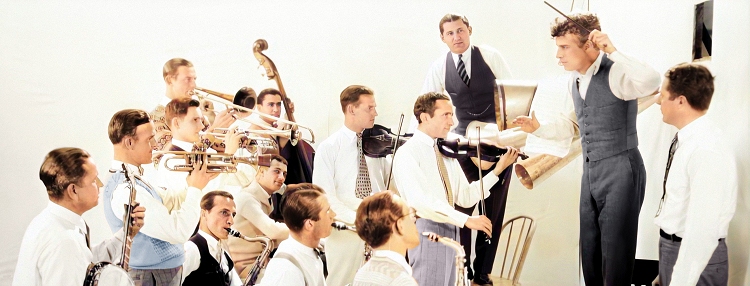 |
The chaos that had, for the most part, only mildly infiltrated the amorous comedian's life to that point, came to the forefront while filming The Gold Rush. While filming The Kid he had engaged a nearly 13-year-old girl named Lillita Louise MacMurray as an angel in a dream sequence, one in which ironically he had flirted with and kissed the girl. She came around looking for work, and Charlie decided to use her as the femme fatale for his new film. Now 16, and renamed as Lita Grey, Chaplin followed what had become a pattern and became romantically involved with the girl during the initial filming in 1924. The affair led to a pregnancy, which led to a more or less forced marriage, which led to shutting the production down while Chaplin dealt with this tenuous situation. Their union was a difficult one from the start, but they would stay together long enough not only for her to give birth to Charles Spencer Chaplin Jr., but also their second son Sydney Earle Chaplin soon after.
Chaplin had to scrap all the scenes with Lita and now employed an film extra who had recently arrived from Chicago, Georgia Hale. The pace of filming was no faster, even though the plot was changed very little during that period.
Even while Lita was pregnant with their second child, Chaplin started an affair with a willing Hale. Their relationship had a bittersweet ending that was later reflected in the sound re-release of the film in 1942, where the final scene with the two characters kissing was excised with a much less romantic shot of them walking into the background.
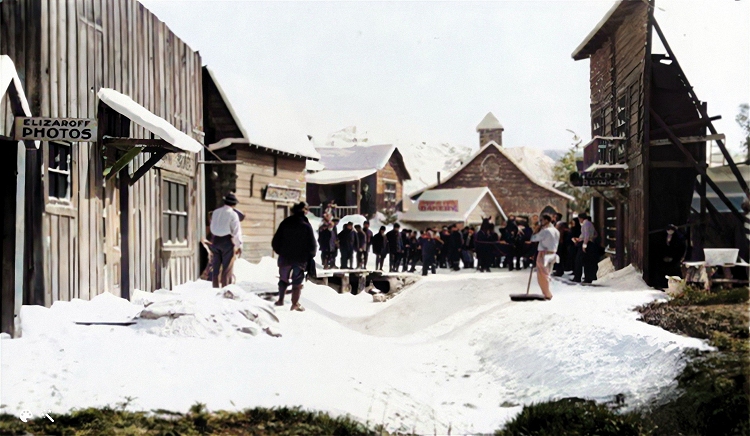 |
The Gold Rush was liked by virtually everybody who saw it, and it further established Chaplin as one of the best film makers of the era. It remains on the top lists of not only the American Film Institute but the Library of Congress and National Film Registry as well. However, there is a distinction to be made between the original and the 1942 re-release which Chaplin himself helped to score from certain selections, and composed some of the music as well. It is more often this version, with narration instead of inter-titles, which is the better preserved and more revered one, in part because of his direct musical involvement.
In addition to his original cues and songs (arranged by professionals but selected by the director), Chaplin liberally utilized Romanze, Opus 118, No. 5, by Johannes Brahms, the folk song Coming Through the Rye, portions of Flight of the Bumblebee by Nikolai Rimsky-Korsakov, and the main waltz theme from Sleeping Beauty by Pyotr Ilyich Tchaikovsky. Even though he did not compose all of the cues, these choices should not be dismissed as many film makers since that time have used similar classical pieces either as placeholders or suggestions to inform their hired composers, or in a stylized manner that suits their film, much as Chaplin did. It showed more than just an appreciation of classical music, going further to reinforce the actions or emotions on the screen with an underscore that was appropriate and not distracting. The few complaints about the 1942 release were more about the rapid-fire narration style of Chaplin than anything else.
After a short period of recovery, Chaplin purchased another reproducing piano, an Ampico, for his home in 1926. That same year he started on The Circus, a film based on love triangle themes that had been previously visited, most notably in his Mutual film The Vagabond. The making of this film was complicated by a legal battle that started with Lita filing for divorce from her famous husband. To the press she wailed that Charlie was starving her and his two sons, while in reality he was giving the lawyers checks, but they were rejected because they were not big enough. Charlie brought charges of defamation against Lita and her attorneys.
The battle became so intense that he had to stop production for nearly eight months while Charlie fought against a seizure of his studio as a marital asset. It was also beset by other issues, such as winds bringing down the main circus tent set, film exposures that proved to be unusable, and a fire that burned all of the standing sets and props.
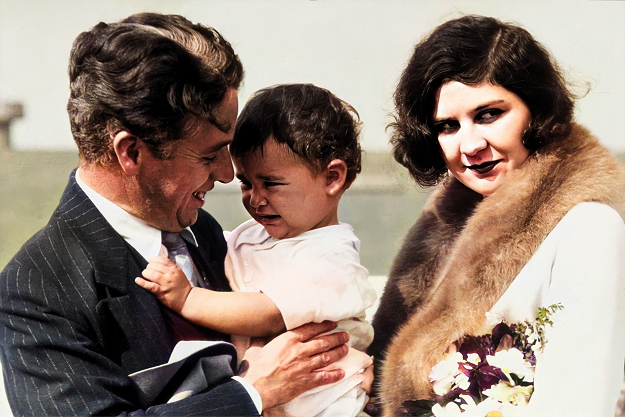 |
At the end of the divorce ordeal both parties dropped their charges and reached an amicable settlement of around $825,000 to support young Charlie and Sydney. It also helped to temporarily get rid of the distraction from the press. However, just prior to the last day of shooting when they took the circus wagons out of town to a friendlier location, the wagons were stolen as part of a college student prank for use as a bonfire. There were other perils while shooting the film, such as Charlie doing stunts on a high wire, and inside a lions cage for a reported 200 takes with the unfriendly beasts. Their mother, Hannah, also died during the filming seven years after having been brought over to the United States. Charlie and Sydney housed her in relative comfort in Glendale, California, until her death. Several years afterwards the half-brothers found out that they had yet another half-brother through their mother, Wheeler Dryden, who had been raised by Charlie Sr.
The Circus was warmly met by the public, and it was enough to earn him his first Academy Award at the very first Academy Award ceremony in 1929 (the term Oscar™ was not yet in use) for "Versatility and genius in writing, acting, directing and producing." He had originally been nominated in several categories, but the Academy instead decided to give him the uncontested special award instead. Had it been a sound film they likely would have had to add "composing," making Chaplin one of the only film stars in history to excel in all five categories (he would later win an Oscar™ for a film score and was considered for one for choreography as well). Chaplin's direct involvement with the work of his favorite and most tolerant cameraman, Rollie Totheroh, might have also brought a consideration for cinematography. When he dictated his biography in 1964, Charlie made only a passing mention the film in the book at all, perhaps because of its painful relationship with the nasty public divorce and his mother's last years.
In the 1930 census, Charles Jr. and Sydney were living with Lita's grandmother, Louise Curry, at 521 North Beverly Drive in Beverly Hills. Lita was listed as living next door at 523 North Beverly Drive. Both were comfortably well off, showing as owning their expensive homes, paid for, no doubt, by Charlie. He was residing at 1103 Cove Way in Beverly Hills, with four Japanese servants and the wife and two sons of one of them, Robert K. Sato. Friendly rival comic actor Buster Keaton, who was listed on the same page just above Chaplin, was living three blocks off on Hartford Way, but would be gone from that household within a year.
Coping with Sound and Soundtracks
For his next act, Charlie would embark on perhaps the most difficult film journey of his career that not only tested his creativity in every way, but his resolve and limited patience as well. Even before The Circus had been released, the entire landscape of the motion picture changed with the release of the Warner Brothers synchronized sound film The Jazz Singer in the late fall of 1927.
Even though most of the dialogue of that film used inter-titles, there was one scene in which star Al Jolson interacted live with his screen mother while playing Blue Skies which clearly showed the potential for sound. Other than Chaplin, Jolson was likely the biggest star in show business at that time, yet the public had seen much less of him since he was known for stage and sound recordings. Nearly overnight, however, many of Chaplin's previous efforts were overshadowed by the introduction of practical sound films.
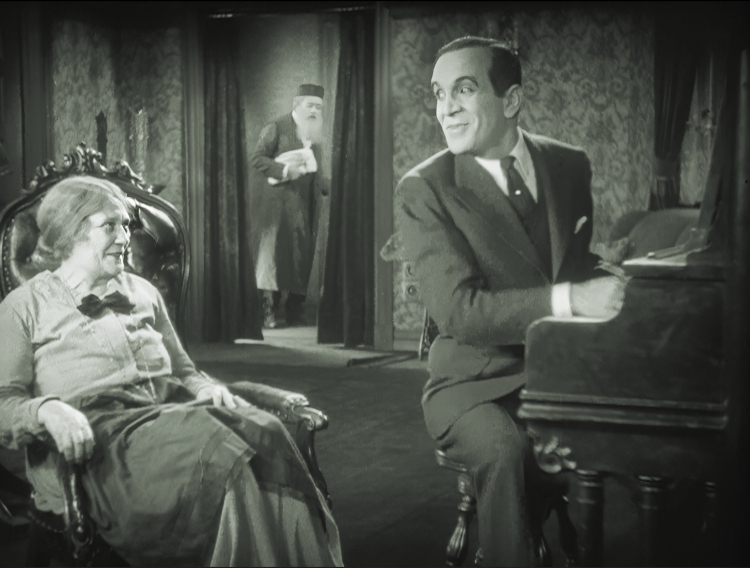 |
Early conversion to sound was not inexpensive for theaters, and in order to accommodate both the synchronized discs of the Vitaphone system from Warner Brothers and the more practical sound on film system from Fox and Lee DeForest, even more equipment had to be installed. Yet by the end of 1928, with almost all of the major studios producing sound films in either format, more than half of the theaters in the United States had made the investment in one or the other system, or both, since that was what the ticket-buying public was crying for. By 1930 silent films would be all but gone.
For Chaplin this conversion presented a multiplicity of problems. For starters, his older films, most shot at an average of 18 frames per second, would not show correctly on the newer sound projectors which displayed films at 24 frames per second. Conversion of older films was costly, so the public soon accepted that silent films would simply look faster than sound films. He had often used undercranking of the film to his advantage to speed up certain portions, and would continue to, but the conversion of an entire film was a different matter.
The bigger problem was that the very thing that made him a star had the potential to be totally negated by sound. Chaplin was a pantomime artist. Many of his films used far less inter-titles than those of his peers, because the action was fairly obvious. Therefore, with only a little change in inter-titles to reflect the country of exhibition, his films did not need translation in any country. They were nearly as funny or moving in Hong Kong as they were in Paris, Berlin or St. Louis, Missouri. Spoken sound would immediately make each film an American or English language film. The use of dialog also negated some of the broad movements of pantomime, which would have been deemed overacting in conjunction with speech.
He was also clear, as were many critics, that sound film had its place as far as presenting musical numbers, but dialog had gotten by just fine with inter-titles for over two decades.
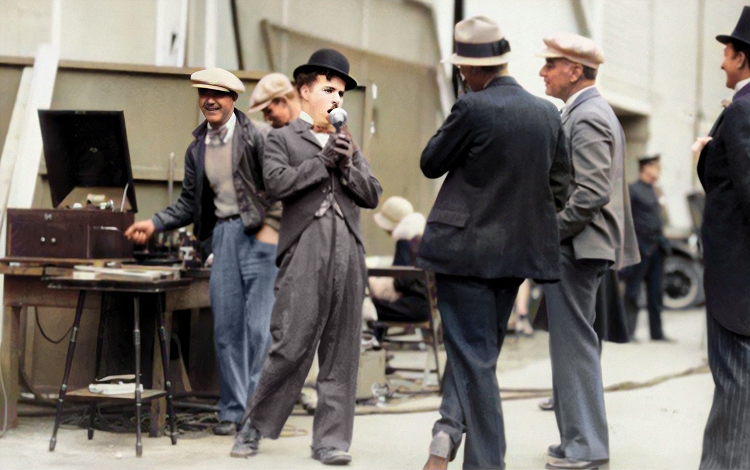 |
City Lights had already gone through several alterations during 1929 and into 1930, most of them for story points. Scenes were shot dozens or even hundreds of times in order to capture a subtlety or an angle, and most were discarded. In the background, Charlie was concerned about how well a silent film would play when the public was asking for sound. He did some experimental takes with sound for one or two days on a couple of dialog scenes, then abandoned that concept. In the end, Charlie proposed that the only difference between this film and his previous efforts was that there would be a unified score distributed with the film by way of a soundtrack. This was the culmination of what he had been trying to do since The Kid.
It was Chaplin himself who either composed or selected the pieces for the entire score of City Lights. He engaged Arthur Johnson and Alfred Newman to arrange and orchestrate his choices, but there was no question who was in charge of the overall execution of the music. While Chaplin was not well trained in Western notation or harmony and theory, he had an innate sense of the emotional and action aspects of the right music. Calling on one of his favorite composers, Richard Wagner, as well as accurately predicting virtually every film composer from Max Steiner (whose score for King Kong in 1933 is regarded as the first fully original film underscore) to John Williams, Charlie worked with specific musical motifs assigned to a character, location or incident.
For the blind flower girl, played by the engaging but problematic Virginia Cherrill, he selected La Violetera (Who Will Buy My Violets) by José Padilla. Chaplin himself composed two other themes for her, one related to her simple but poor flat (apartment), and the other for emotional reflective close-ups. Additional musical devices composed by Chaplin include a fanfare which opens the film and is heard in a few places announcing another pending calamity, and a galop reminiscent of those of the 1890s or early 1900s for some of the action scenes. There is also a theme for his tramp character as he wanders through the lonely city, appropriately enough played on cello, although not by Chaplin himself. A faster theme played on the bassoon was used to accentuate his humorous moments.
Another predictive device was to substitute speaking with or through a saxophone for prattling dialog, similar to what would be used for adult speech in the Peanuts cartoons of the 1960s to 1990s. The rest of the cues were composed or cut to the action on the screen, also predictive of cartoon scoring of the late 1930s and beyond.
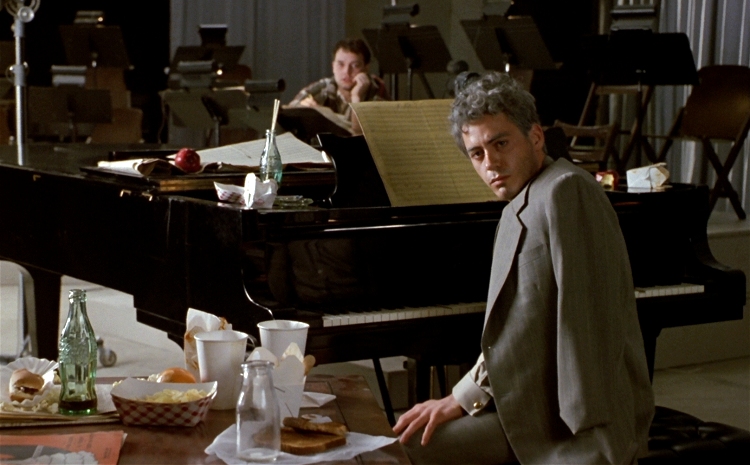 |
Chaplin did stray from his traditional background which included a healthy dose of classical and older popular music, and called on contemporary forms to keep the film current and vital. For a scene where he and the millionaire character played by Harry Myers go to some of the hotspots in town, a bustling jazz theme played by a smaller ensemble is used. It is contrasted with a Latin rhumba for a party at the millionaire's mansion. A dramatic motif was used in association with the suicide attempt of the millionaire, in addition to two different themes for his highly contrasting drunken and sober moods. A couple of other familiar themes were inserted as well; a snippet of Scheherazade by Rimsky-Korsakov played in two different timbres, and the more common How Dry I Am often used by arrangers for scenes involving alcohol. Most of the sound effects were also done with instruments with the exception of, literally, bells and whistles.
While most films of the time were using underscore sparingly, often interspersed with on-screen musical numbers, the entire soundtrack for City Lights codified his abilities and instincts not only as a composer but as a competent score writer, which requires a different skill set. Musically he was able to clearly define comedy, pathos, wistfulness, whimsy, and even love. Everything from English music hall motifs and ragtime through classical, jazz and loosely defined tangos. Some of the themes from City Lights were also rescored and used in a clever fashion by director Attenborough in the 1992 film Chaplin.
There were many issues with the film, including the contentious relationship between the director and his co-star, Virginia Cherrill. He considered her an amateur in every way, and even fired her at one point. After a failed attempt at trying to fit Georgia Hale into the role, he brought Cherrill back to finish the film. After more than two years, City Lights was finally unveiled to a wary public in January, 1931. In spite of the lack of dialog and Chaplin's concerns about the public's reception, City Lights was an enormous financial success, just right for audiences in the deepening Great Depression who needed a heartwarming story that favored the poor over the rich. It was critically acclaimed as well, not only for the acting and writing, but for the effective use of music.
He was uncertain about how it was to be perceived by the public, now yearning for talkies. The first sneak preview to a half-full house did not go well. The Los Angeles premiere, where Charlie sat with the Einsteins, was interrupted in the middle by the manager who wanted to talk about his new theater. But Charlie was more worried about New York, which could make or break his valiant effort. He rented the 1150 seat George M. Cohan Theater on 42nd Street for $7,000 per week for eight weeks, paid to fit it for sound films, then set out to charge more ($0.50 to $1.00) for his showing than most other movie theaters in New York were doing. In the end, Chaplin's instincts won out, and they trumped most of the nearby theaters in terms of attendance and profits. City Lights, the semi-silent gamble, was a critical and public success, much needed after his failed marriage and faltering career.
Chaplin had reached a new zenith in the creative process of the cinema. It would be five years until he unveiled his next act, and something else quite new where his fans was concerned. However, the news mongers were able to find enough to keep him in the press, and Chaplin's sometimes unraveling life certainly gave them material.
New Horizons - The World Tour
At nearly 42 years of age Chaplin's hair had partially turned white, perhaps from stress as much as heredity. Mabel Normand had died. Comedian Buster Keaton had been demoralized by his troubles with MGM and was becoming an alcoholic. Doug Fairbanks was having major issues in his marriage to Mary Pickford. Roscoe Arbuckle had barely survived three harrowing trials that proved him innocent, yet destroyed his film career, and would be dead within two years.
Many actors in Hollywood were finding that they did not sound quite how they looked, and they also lost popularity with the public.
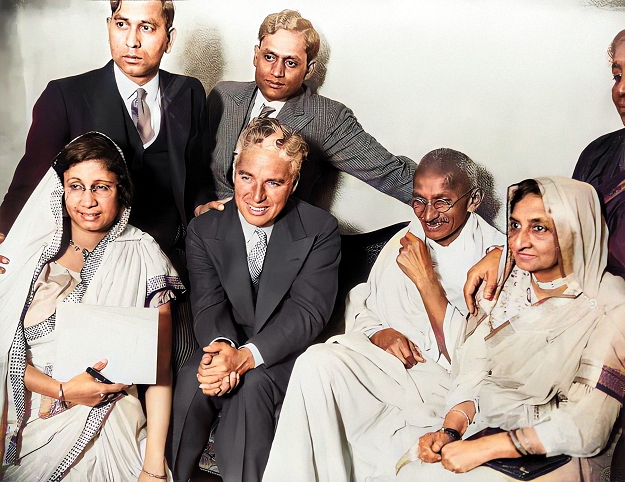 |
Although he was often discouraged by having to battle misinformation or private information found in the press, Charlie still maintained a nearly religious dedication to his art, and his energy remained undiminished, even if his enthusiasm had faded a bit. In need of a rest and a change after City Lights, Charlie, his long-time Japanese valet and chauffer Kono, and his friend Ralph Barton, who had recently attempted suicide and was in need of a new perspective, set off that Spring on a 1931 world tour that would last for the better part of a year. The first stop was London where he attended the British premier of City Lights. They gathered a few companions along the way for some legs of the journey. One of those was May Shepherd, hired in London as his personal secretary for the duration to read and respond to correspondence. There have been reports that she went out with Chaplin and his entourage and had an affair with Chaplin, but correspondence confirms that she stayed behind in London. She did, however, have access to many of the salacious offers mailed to the star, or letters recounting previous passions, and used that in her favor later in the year to leverage for higher pay.
Sydney had already moved to Europe and he and his wife Minnie were living in Nice at that time. Being the brother of somebody so famous and at times controversial made it hard for Syd to hide from any transgressions, real or perceived. After ending his association with the film industry a couple of years earlier and selling out his shares, tax investigators questioned the reliability and validity of his claimed income. The couple first went to England, but found matters to be just as bad there. Thus it was in France where Sydney Chaplin would be found in 1931.
Having not been to London for a decade, Charlie found his tumultuous reception there had been magnified considerably from that of 1921, and with much more media present. Of course the star was invited to many events, including a dinner given in his honor by American born Lady Astor. He also was able to visit and spend more time at the familiar and bittersweet locations of his youth, including the boys home. The question had been brought up concerning his receiving a knighthood.
It has been considered that his involvement with underage girls and some of his political stances of that time kept Charlie from being honored as such in Buckingham Palace. Such an honor would have to wait. He also managed a visit with esteemed author George Bernard Shaw and Winston Churchill among other dignitaries, and spent more time with his friend H.G. Wells.
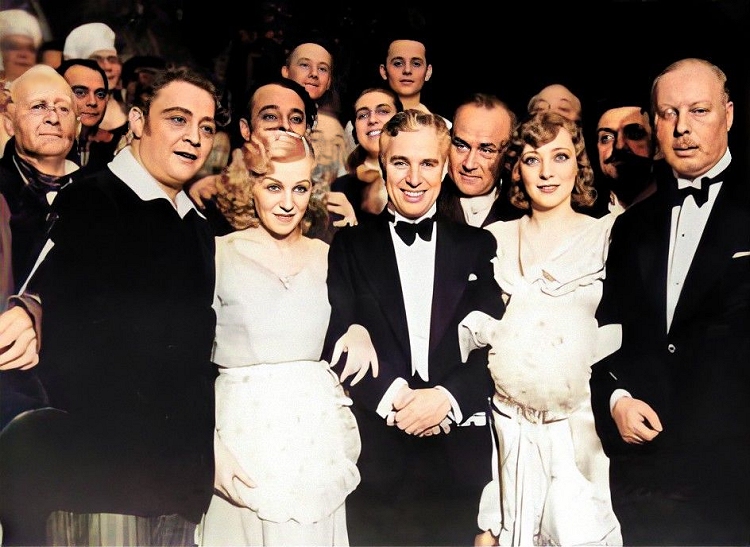 |
Chaplin had the privilege of meeting with India's biggest advocate and future leader, Mahatma Gandhi in Canning Town, London. It was the only time Gandhi would be in England, where he had been schooled, between 1914 and his assassination in 1948. Both the spiritual leader of India and the creative leader of comedy had large crowds surrounding them when they met, largely by happenstance, in the poor East End of London. Photographs were taken of Charlie with Gandhi and his family. They exchanged some dialog about the leader's struggles during a time when the Indian people were boycotting British machine-made fabrics, then both went on their way. Charlie and his friend Ralph Barton, who was still depressed after five unsuccessful marriages, visited Ralph's daughter in a London convent. There he learned that she would be going to Africa on a mission, but that outside contact was discouraged. Charlie then bid Ralph adieu, and he sailed back to New York City where he would be found dead by his own hand within two weeks.
The remaining party's next stops were in Weimar and Berlin, Germany, where his equally enthusiastic reception by the public would later be utilized in propaganda specifically against the comedian and the countries and alleged race that he represented. Chaplin would, in turn, use that propaganda to create a brilliant and eerily accurate response in one of his finest screen appearances. Even more than a decade after the war, his films had been banned in Germany in response to Shoulder Arms (1918) in which he handily defeated many German soldiers. Yet none of this seemed to dampen the legions of fans he had in Berlin, whether they came out to see an American celebrity, or had perhaps seen some of his contraband films in underground theaters. Among the stops they made in Germany were the royal palace where Frederick the Great had once dwelt, and back to the simple home of physicist Albert Einstein and his family, who had already been Chaplin's guests in Hollywood. One other visit was with singer Marlene Dietrich. The two had no connection other than mutual admiration, so there it has been historically considered that there was no publicity motive involved with their meeting.
Next on the agenda was a return to Paris. Chaplin was met at the station, and pretty much everywhere, with the same adulation he had found all along the way, if not even more intense. As in Germany, some parts of his clothing disappeared while trying to get to local transportation. He met with King Albert of Belgium, trying to address him as he would anybody, and finding out that Kings really do get special treatment.
Charlie visited the tomb of Napoleon, a character he had flirted with playing now and then, but was reluctant to do so lest he upset the apple cart of fame for the sake of art. Staying later in Normandy with the Duke of Westminster, Chaplin experienced his first boar hunt and first time on a horse in years. He also spent some relaxing days with Sydney and Minnie at the French Riviera.
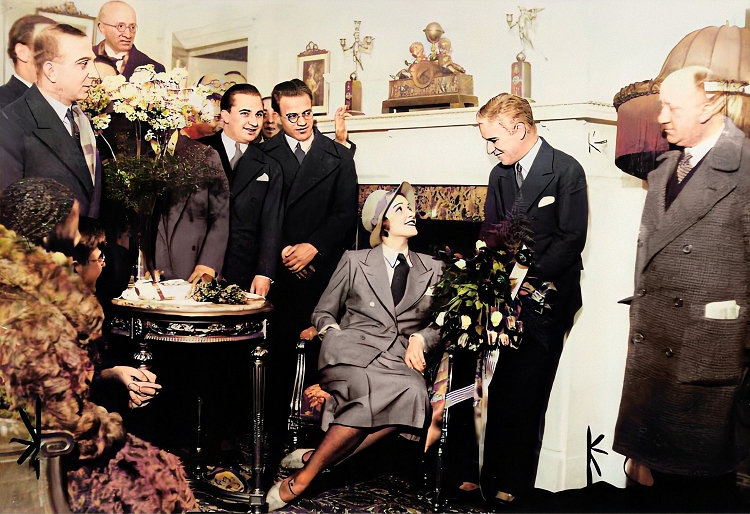 |
While studying the casinos in Nice and deciding they weren't for him, Charlie spotted dancer May Reeves, who Sydney said he knew. A meeting was arranged and Charlie was soon enamored with, then involved with her for some time during the remainder of the European portion of their extended trip. May fell for Charlie, although she was reluctant to even think of marriage. H.G. Wells again met with Charlie in France, and the combination of the two created enormous crowds everywhere they went. He also had a chance to spend time with Edward, Prince of Wales, and his wife.
The entourage ventured back to London briefly in September, without May, to deal with business. A small part of this London visit was spent in dealing with Shepherd and her knowledge of Charlie's intimate life through his correspondence. A satisfactory arrangement was eventually realized. He also spent considerable time with the Prince of Wales.
Then, several months after having left Beverly Hills, the party went to Switzerland in December where his long-time friend Douglas Fairbanks was staying. Charlie, missing his new love, sent for May and she rejoined him there. They were inseparable for some time, but Sydney made clear some of his disdain for Charlie's public escapades and affairs, which it appeared he more or less ignored. Many thought that May would be that elusive perfect wife for the comedian. She clearly loved him and brought some stability to his demeanor. But Charlie simply never it took it that far, in spite of or perhaps because his obvious affinity for her. The group left Switzerland for Italy on their way to the Orient, with Sydney in tow. While in Italy, United Artists tried to have Charlie meet with the country's fascist Prime Minister Benito Mussolini, who was already going by the title Il Duce. Fortunately for the reluctant Chaplin there was no time available in the leader's day, and he escaped what with hindsight would have been perhaps an even larger crushing blow than those that would eventually land on him.
By the time Charlie was on the ship to the Far East it was clear that May could not go along, and it was the last they ever saw of each other.
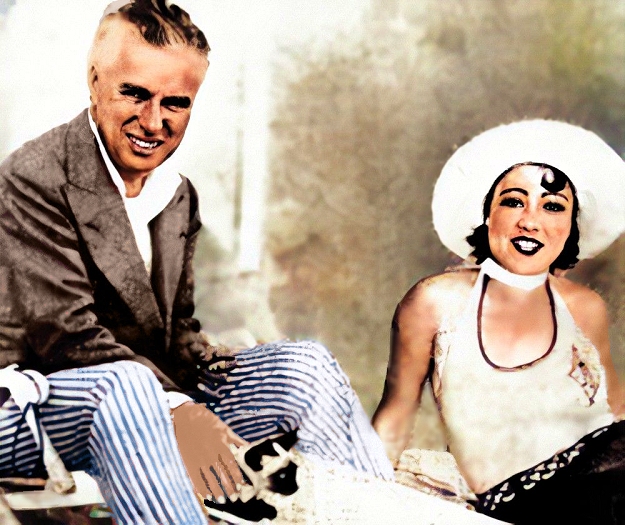 |
For the next two months, Charlie, Syd and friends toured Singapore, Ceylon, Java, Bali, and parts of the South Pacific. Charlie particularly enjoyed Bali, admittedly because so many of the women there walked around bare-breasted, but also because the culture had not yet been spoiled by Western influence. Even in these remote spots of the world, silent films had long been known and still presided, particularly those of Chaplin and his peers. Silent comedy needed no translation, so Charlie found himself beloved in even the more remote ports he visited that had the electricity to run a projector. Even though he was met with more subdued crowds in these countries, they were present nonetheless. However, the next highlight of the trip for Chaplin would be Japan, which they reached around June. It was also familiar territory to his companion and valet Kono, who preceded the party there by a few weeks to prepare the way.
A couple of years before, according to accounts by Kono, Charlie had attended an authentic Japanese play in Los Angeles and was captivated by the mixture of pantomime and music that was not only indigenous to Kabuki, but to Chaplin as well. He had made this clear to Kono at that time, then let the matter drop until the pending visit loomed in the immediate future. To go to Japan and experience it in its native environment was something he had looked forward to for a long time, and now asked Kono to help enhance that experience. The visit was extremely well publicized, and the government made sure that Charlie would realize all of the conveniences and opportunities they could afford him and his party. On the train from the port to Tokyo, they were ordered to stop at every station for a few minutes while Chaplin was seen by the immense crowds, and received all manner of gifts from local officials, such was his universal fame even there. While in Japan Chaplin enjoyed the trapping of fame, but more importantly their exquisite sense of storytelling through theater. It was one of the big highlights of his trip.
The stop in Japan could well have been his last. Although it took several years for the details to emerge, Kono had been approached before Chaplin arrived, warning him that his boss was in potential danger. As a sign of allegiance they asked him to have Charlie bow before the palace in Tokyo (stating that it was a tradition) before he even got to his hotel. While attending an event with the son of the Prime Minister, the son was called away with urgency, and when he returned a little while later relayed that his father had just been assassinated at his home by renegades from the Japanese Navy, and had he been there he would also have been a victim. Since suspicious activity had also centered around Kono, Charlie thought that there was more to the story. Chaplin found out years later that he was also a primary target as a symbol of America, but that they decided otherwise during his visit. He joked that if they had found out after his death that he was actually British that they would have politely said, "Oh, so sorry."
Then after nearly a year on the road, Charlie returned to Hollywood and world of the movies he had momentarily left behind. He had taken in a lot of world culture, absorbing facets of musical and creative arts as well as political ideas. Not having had the deadlines and expectations of creativity thrust on him, even if self-imposed, for some time, he came back weary but refreshed, and ready to tackle new horizons, including one big idea that had been running through his head for some time. However, as Chaplin would soon find, his charmed existence had lost some of its luster in his absence, and there was a difficult road ahead creatively, personally and politically.
The End of The Tramp - The Growing Turmoil
In spite of his new enthusiasm, Charlie felt a bit like a bum because he was not working and did not have an idea of what to do. Some of this was caused by the onset of sound, and he did not have a clue for several more months how he would make the tramp work in a sound movie. He even had thoughts of hanging it all up and moving to Hong Kong.
Then, recalling some of the discussions on his trip and some recent books he was read, he started to develop his next project. It was a pre-George Orwell look at the growing role of automation and martinet-like dominance over the American worker. While not overtly or consciously socialist in nature, it was his outlet to rail against some of the facets of progress that doomed those who were very much like his little tramp; the hapless everyday man with no direct recourse against authority. The idea had been around a while and germinated during his tour, viewing the ravages of the world-wide depression that had taken hold by then. So the core of the film project was ready to go in late 1932. He now needed to make decisions on the use of sound, and casting as well.
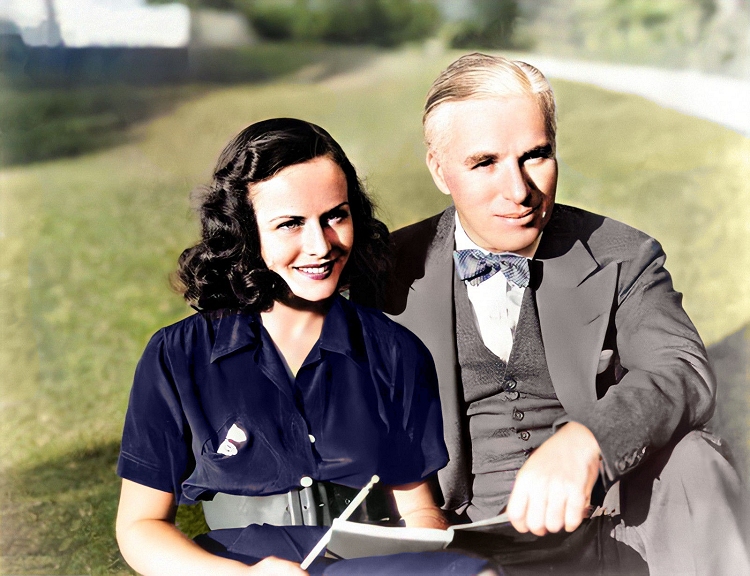 |
One of the lead roles, and indeed an inspiration for the film itself, came about after a weekend on the yacht of Joseph Schenck, president of United Artists, in late 1932. Schenck and his younger brother Nicholas, would fairly soon be two of the lesser favorite Hollywood executives, between UA and MGM, but they still knew how to conduct business effectively. On that trip to Catalina Island, two actresses joined the party, one of them a former Ziegfeld girl and now contract player named Marion Pauline Levy. She was 22 at that time, historically a little older than Chaplin's taste had run, and had already been married and divorced once. But the actress had a childlike quality that Charlie instantly took to.
Charlie soon cast her under the name of Paulette Goddard in the role of the orphaned gamin in his upcoming film Modern Times, and before long the two took up residence together. The question remains to this day as to whether they were actually married. Both avoided answering the question as best they could, and told friends they had been married privately, either in China or at Sea. For a while, at least, few cared because they seemed made for each other. There were a few in Hollywood who saw their apparent co-habitation as scandalous, and the first rumblings were heard of making an example of the foreigner who had not even attempted to gain U.S. citizenship.
While making Modern Times, Charlie was either oblivious to this talk or simply didn't care. He was focused on the elements of producing, directing, casting, acting, set layout, and most importantly the use of music and sound. The role of the machinery required large sets, and the outdoor locations found contrasted the clean factory with the reality of the Great Depression that had settled in. The small shanty set up for the tramp and the waif bore striking similarity to many that had sprung up in public parks around the country, including Central Park in New York City. He also engaged the use of a downtown department store that was undergoing renovations for a daring and dangerous scene on roller skates.
While the formation of the plot and filming took a relatively short period of time, considering Chaplin's history, the application of sound and music merited a great deal of both pre and post production.
He had decided that all speech would be through machines, such as radios and a facsimile of early wall televisions that even invaded the privacy of the washroom. The remaining dialog would be through inter-titles or replaced by pantomime. There was one exception, however, which set the film world on its ear - Chaplin's tramp would not talk, but he would sing.
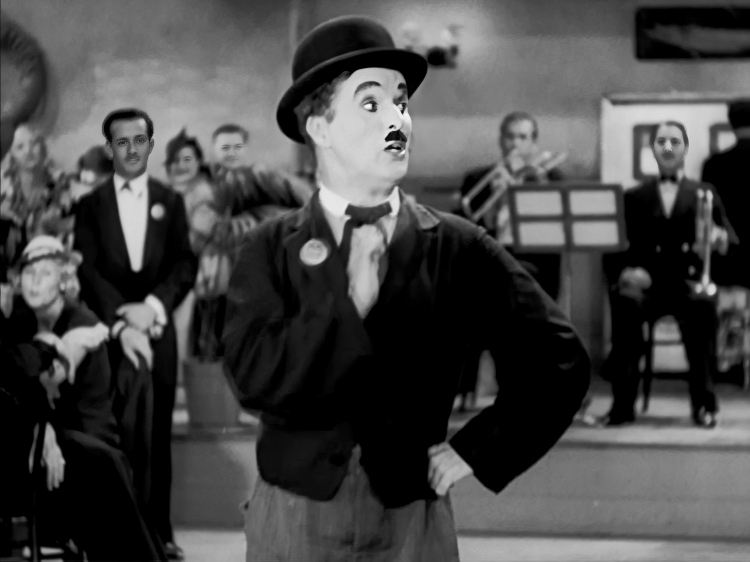 |
The way Charlie went about this very revelation was with a measured and intelligent approach. He chose a popular French tune from 1922 which had been a minor hit in the United States in 1925. Titina (Je Cherche Après Titine) had both French and English lyrics. However, Charlie chose to make up a nonsense set of lyrics with a mish-mosh of non-words and mangled European phrases. They all rhymed when necessary and some were close enough to reality that the idea of them was understood. However, it was, in the end, his performance of the piece with a live orchestra on the set that suggested what he was trying to get across. In a sense, he had created a musical pantomime in which the use of pauses, accelerations, and even vamps contributed to the way the lyrics were conveyed to the screen audience on the set as well as the theater-goers. It was a way to keep the tramp from being le Tramp Americán, while displaying his inherent musical talents.
Following the scoring success of City Lights, Charlie also wrote much of the score and underscore, using key classical or popular pieces for the remainder, and spending weeks in the studio with an increasingly frustrated Alfred Newman, who eventually abandoned the project in need of sleep and sanity. His name still appeared on the credits. In addition to the music, Chaplin also directly oversaw or contributed to most of the sound effects used in the film. In later years he would write about this part of the creative process and how important it was for him to be involved, referring with some ambiguity to Newman or his colleague Arthur Johnson:
One happy thing about sound was that I could control the music, so I composed my own. I tried to compose elegant and romantic music to frame my comedies in contrast to the tramp character, for elegant music gave my comedies an emotional dimension. Musical arrangers rarely understood this. They wanted the music to be funny. But I would explain that I wanted no competition, I wanted the music to be a counterpoint of grace and charm, to express sentiment, without which, as [English critic and writer William] Hazlitt says, a work of art is incomplete. Sometimes a musician would get pompous with me and talk of the restricted intervals of the chromatic and the diatonic scale, and I would cut him short with a layman's remark; "Whatever the melody is, the rest is just a vamp." After putting music to one or two pictures I began to look at a conductor's score with a professional eye and to know whether a composition was over-orchestrated or not. If I saw a lot of notes in the brass and woodwind section, I would say: "That's too black in the brass," or "too busy in the woodwinds". Nothing is more adventurous and exciting than to hear the tunes one has composed played for the first time by a fifty piece orchestra.

As he had done for City Lights, Chaplin assigned specific motifs or themes to characters and situations. There was, however, one tune that permeated not only the film, but the hearts of those who would soon hear this song that warranted a separate publication. For anybody who had claimed that Chaplin's composing was pedantic or uninspired at best, they only needed to listen to the melody Smile to understand this to not be the case. The lyrics, which were added 18 years later in 1954 by John Turner and Geoffrey Parsons, were approved by Charlie and spoke true to character of the tramp that he had portrayed for over two decades by this time. They also speak true to the sentiment of the beautiful and poignant melody: "Smile, though your heart is aching, Smile, even though it's breaking. When there are clouds in the sky, you'll get by."
Modern Times opened in February, 1936, and both critical acclaim and controversy soon followed. It was evident to many that the tramp would now be history, particularly because in the end of this film, he not only gets the girl but he keeps her, for the first time walking off into the distance with her on his arm. But there was trouble from Europe as well. Tobis, a French and German film company, claimed that Chaplin had stolen some of his ideas from their similarly themed 1931 film A Nous la Liberté. The director, René Clair, an admirer of Chaplin, was not totally on board with this contention and noted that he was quite embarrassed by the proceedings. The court case floundered and was dropped during World War II, but came back again in 1947 with a request to suppress Modern Times from exhibition. Chaplin and UA settled not as an admission of guilt, but to make the issue go away.
There were also articles lambasting Chaplin for his indictment of progress and the American way of life, which in part was the intent of the film, but claiming him also to be against what America stood for. One authority figure of note, FBI director J. Edgar Hoover, had started a dossier on Chaplin even before Modern Times and took note of these views. However, his role in later controversies as portrayed in the 1992 biopic was exaggerated for the sake of having a protagonist, and he was not so active in anti-Chaplin sentiment at that time. If Charlie had any one public enemy who could turn the public against him, it would be popular print and radio columnist Hedda Hopper. For the time being, Modern Times was well-received, and did not overtly polarize moviegoers and Chaplin critics like his next film would.
Starting in 1937 the government and certain members of the public started to pay more attention to organizations that Chaplin either purportedly supported or was even peripherally involved with.
After actor Erol Flynn was falsely accused of financially helping Spanish Loyalists in the war in Spain against the Fascists, a cable to Chaplin surfaced thanking him also for his help with the Catalonian People who comprised the majority population of the country. Both actors came under public scrutiny for these associations. The "Red Scare" was not yet upon the country, but by 1940 there would be incidents affecting every studio from MGM to Disney concerning overbearing unions and links to communism. As of the 1940 census, taken in Beverly Hills, Charles and Paulette were actor and actress respectively in motion pictures. He had retained his staff of three, a Dutch maid, and his cook and chauffeur, both from Japan.
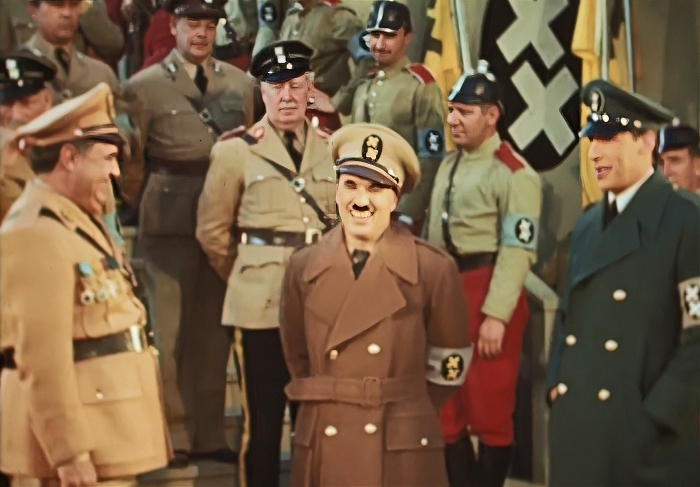 |
On the other side of the equation, in the late 1930s, the Nazi government released a book and a film, Der Ewige Jude (The Eternal Jew), deriding the reception that the German people had given the American comic in 1931, and making the claim that no "Juden" (Jew) was worthy of such an honor. (Charlie later wrote clearly that "'No, I am not Jewish... but I am sure there must be some somewhere in me. I hope so.") While trying to shame the German population, the film also incensed Charlie who started paying much more attention to what was happening in that country. The resemblance between Chaplin (with his moustache) and German dictator Adolf Hitler was not lost upon him, nor was the fact that they were born only four days apart. The idea of parodying Hitler in a comedy started to take shape after the German film was released. Indeed, many others noticed as well, including a clever British songwriter who got around a BBC ban of mentioning Hitler's name outside of the news by composing Who is This Man (Who Looks Like Charlie Chaplin).
In early 1938, Chaplin had visited author John Steinbeck at his home, seeking a conversation and autographs of two books. At that time Steinbeck had no idea who he was actually talking to, and a few months later in Hollywood he was reintroduced to Chaplin, and felt very embarrassed about the first meeting. They talked for many hours, and Steinbeck, who had no interest in various offers to write for films, agreed to help Chaplin with the plot and writing for his first talking film.
The Great Dictator had been a work in progress since perhaps 1938, but as conditions changed in Europe, especially for the worse for the Jewish population, certain elements of the plot also had to be changed to reflect the seriousness of the situation. Hitler was already a target as the lead character, but when Mussolini made it clear in the press that "The Italians do not find Mr. Chaplin funny," he warranted an important part in the film as well.
Chaplin endured fights with United Artists and many of his friends and advisors, as well as a number of anonymous threats from the public who did not understand the efficacy of the potential commentary that would result from his making a satire of the German Füehrer and his horrendous actions. However, he also received direct support from President Franklin D. Roosevelt, who sent an advisor to the set to review the script and encourage Chaplin to complete his project in spite of any public or private objections.
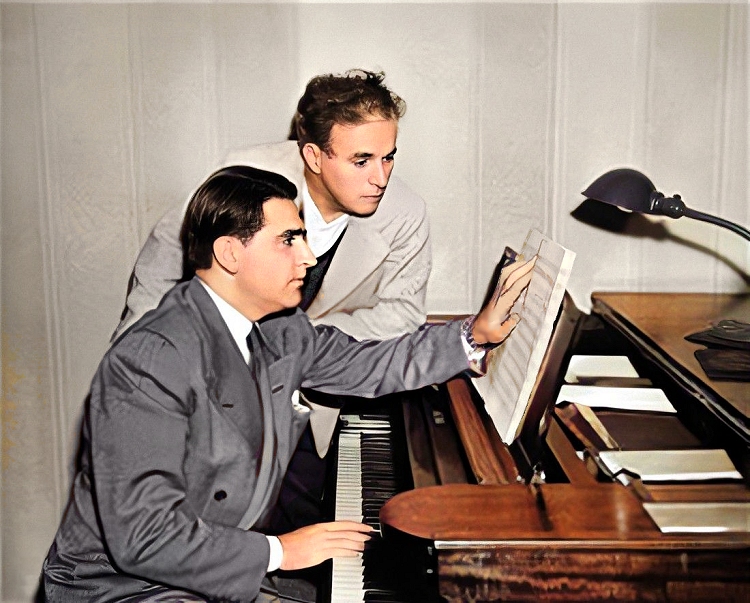 |
In the story, Chaplin, who was not Jewish by birth (Sydney was half-Jewish from his mother), played the part of a Jewish barber who had been injured in World War One, and after twenty years of amnesia suddenly came out of it and returned to his shop. He also plays Adenoid Hynkel, the dictator who was running Jews out of the cities and into unknown regions. Mussolini was brilliantly represented in the character of Benzino Napaloni (Mussolini morphed with Napoleon), and Hitler's interior minister Joseph Goebbels became minister Garbitsch. For the most part the upper hierarchy of the countries involved as well as the army was parodied, and not always played for laughs. The Jewish characters, while providing some humor, were closer to their actual real-life counterparts.
Not only did Chaplin have to bring balance to the story, of which the ending was drastically changed after the invasion of Poland in 1939, but to his use of dialog and sound as well. As Hynkel he gave outrageous speeches of mixed German nouns, including food items and a nonsensical tirade against "Der Juden." As the barber he needed to be genteel yet urgent with his resolve. Having already tackled the art of composing for his films, Chaplin now needed to at times tune the acting and the timing to the expected tone of the score, so the musical aspects of the film informed him of the emotional ones, even before the score had been recorded. The trickiest aspect of this highly predictive film showing the expected direction of events in Europe with some modicum of accuracy, was the ending speech, which was written near the end of production after the Germans had invaded France.
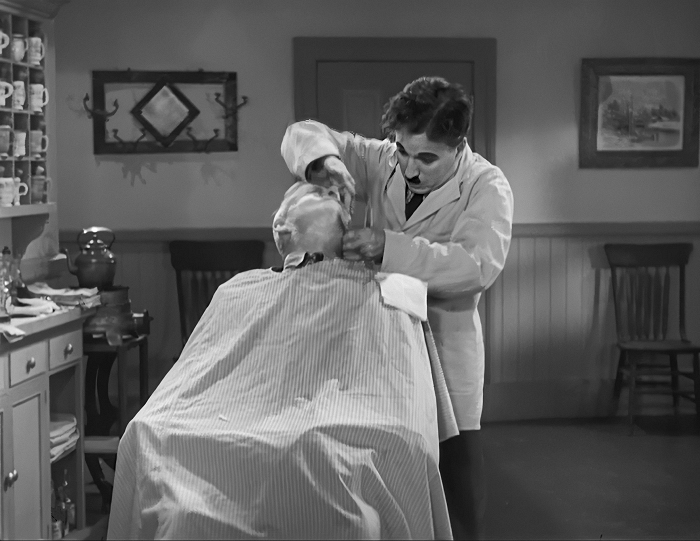 |
This time Charlie had conductor Meredith Willson at his side to do the scoring of the Chaplin melodies. With Willson's assistance, the music Chaplin either composed or selected perhaps subconsciously prepared him for his first driven and emotional dialog scene on screen, the barber's speech at the end of the film. That speech starts out simply and tentatively, building to an enormous climax in concert with the score. The music selected was the Prelude from Lohengrin by one of his favorite composers who he had called on before, Richard Wagner. Another seminal musical moment also utilizes that same Prelude as he toys with the idea of world domination by tossing an inflated globe around in his office. An almost identical globe, albeit not inflatable, was known to have existed in Hitler's office, and was one of the few remaining items found there after his suicide.
One of the cleverest uses of music with action in the score of The Great Dictator not only was a tribute to the pantomime of his tramp character, but was later copied by Chuck Jones in 1950 for his Bugs Bunny cartoon, Rabbit of Seville. While the wascally wabbit performed his tonsorial duties on customer Elmer Fudd to the music of Rossini, Chaplin did his amazing shave of a customer to Johannes Brahms' highly popular Hungarian Dance #5. While anybody familiar with film would imagine that this particular track was recorded in advance for shooting, the orchestra had not yet been hired as the score was not completed. So instead, Chaplin rehearsed and performed the delicate routine with no cuts (in the film or on the customer) to a phonograph record. Willson intended to record the orchestra in short segments of eight to sixteen measures for better ease of editing to fit the timing on the screen. However, at Chaplin's insistence, he did one full rehearsal take with the orchestra conducting to the film, and they nailed it in that one take.
When Chaplin was interviewed in 1940 about working with sound and music, he stated that "Film music must never sound as if it were concert music. While it actually may convey more to the beholder-listener than the camera conveys at a given moment, still it must be never more than the voice of that camera". Willson, working on his first major film project, had much more to add about his employer both in contemporary interviews and in his 1948 book And There I Stood with My Piccolo:
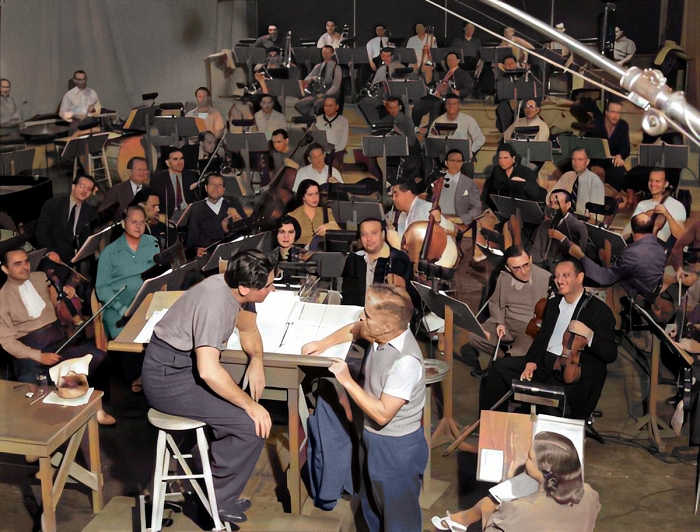 |
I've seen him take a sound track and cut it all up and paste it back together and come up with some of the dangdest effects you ever heard — effects a composer would never think of. Don't kid yourself about that one. He would have been great at anything — music, law, ballet dancing, or painting — house, sign, or portrait. I got the screen credit for The Great Dictator music score, but the best parts of it were all Chaplin's ideas, like using the Lohengrin Prelude in the famous balloon-dance scene.
On his experiences with The Great Dictator and City Lights, Chaplin was a bit more introspective in a later recounting of his role as a composer and his association with musicians compared with others engaged in various creative disciplines:
Writers are nice people but not very giving; whatever they know they seldom impart to others; most of them keep it between the covers of their books. Scientists might be excellent company, but their mere appearance in a drawing room mentally paralyses the rest of us. Painters are a bore because most of them would have you believe they are philosophers more than painters. Poets are undoubtedly the superior class and as individuals are pleasant, tolerant and excellent companions. But I think musicians in the aggregate are more cooperative than any other class. There is nothing so warm and moving as the sight of a symphony orchestra. The romantic lights of their music stands, the tuning up and the sudden silence as the conductor makes his entrance, affirms the social, cooperative feeling.
In spite of the outcry from certain factions in Hollywood, and the public, The Great Dictator opened to great acclaim in October 1940, and was ultimately Chaplin's biggest moneymaker. Even though the British government had made it clear in 1939 that they would ban the film from exhibition, by October 1940 the situation was clearly much different, and they stepped aside. In London The Great Dictator opened around the time of the German blitz on that city, so provided literal comic relief from the drastic situation they were experiencing in England. It also received great support from the Jewish community, only a few who were even somewhat aware of the horrendous actions being taken against their race in Germany at that time. Hitler was said to have viewed it at least twice, laughing at some scenes and clearly scowling at others. Chaplin later said that had he known about any part of the Holocaust, he likely would not have gone ahead with the project. The entertainment and political critics were glad he had done it. One of the theme melodies from the score would later be released with lyrics under the name of Falling Star.
The Great Dictator was nominated for five Academy Awards, including Best Picture, Best Actor in a Leading Role (Chaplin), Best Supporting Actor (film comedian Jack Oakie as Benzino Napaloni), Best Original Score (Willson), and Best Original Screenplay (Chaplin). Whether it was simply first rate competition from others in those categories or the politics of the voters of the Academy, The Great Dictator ultimately ended up with only the acclaim, and none of the awards. It would also, like Modern Times, spur a plagiarism suit from Konrad Bercovici who claimed to have written at least some of the story. While Steinbeck likely had a little more to do with it, Chaplin finally settled for $95,000 in 1947, in part to stave off any more negative press during a time of rapidly waning popularity. Even as the dust settled and the United States prepared for war with Germany, and were surprised by a military attack from the Japanese Empire, more of the personal wars of Chaplin were just around the corner as well.
Not All is Fair in Love and War
The next major film of Charlie's would find its birth in 1941, but it would be six years of misery and distraction before he could get it to the screen. In the interim, he did manage to resurrect his most venerable and beloved silent film for sound in 1942, The Gold Rush, by composing and compiling a new score, adding narration in place of inter-titles, and doing a little re-editing and excision.
Some film historians consider the redux of this story to be better than the original cut even though it leaves out the final kiss. Others feel it was butchered or over-revised. In either case it was the beginning of a successful project that would take most of the rest of his life - resurrecting his older silent films with new musical scores and some minor editing. The work also yielded Oscar™ nominations for scoring (Max Terr) and sound (James L. Fields).
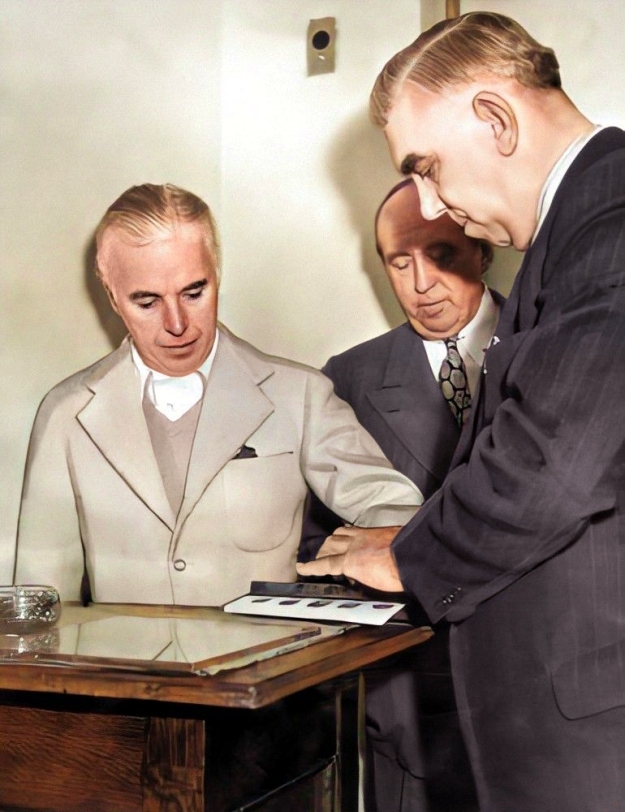 |
The combination of his sometimes obsessive workload, hyper-focus on his work during The Great Dictator, and short attention span in other areas of his life spelled trouble for is relationship with Goddard, and by 1939 the two had been separated. In 1940 they announced that they had been married four years earlier, in part to squelch continuing speculation and criticism. Two years later Chaplin made an amicable legal settlement with Goddard, who continued on with her own career at Paramount and other studios. Charlie's next distraction would be his undoing, albeit unfairly.
Her name was Joan Barry (a.k.a. Mary Louis Gribble), an American actress of no particular distinction. Chaplin had hired her to his studio in mid-1941, keeping her on retainer will making sure she had acting lessons to realize her potential and help alter her nasal New York accent. Fixated on her form and figure more than anything else, Charlie had a short affair with Joan in mid to late 1942, but ended it after she proved to be mentally unstable. Barry would come to his home to harass him from outside, trying to gain sympathy and entry, and having to be taken away by police on a couple of occasions.
Ten or eleven months after their involvement allegedly ended, Barry gave birth to a girl, Carol Ann, and claimed that the child was Chaplin's. Charlie immediately and emphatically denied that this was possible and submitted to a blood test to prove the fact that he was not the father. However, Barry's attorney, Joseph Scott, did all he could to convince the jury that Chaplin, who had shown an affinity for underage girls and lurid behavior, was still responsible, and convinced the court that the blood tests should not be admissible as evidence. In late 1943 Chaplin was ordered to give Barry child support for the next eighteen years, which he did, in spite of the injustice, to help negate the already sensational and damaging publicity the trial had generated.
To add to his problems, Federal Prosecutors charged him with a violation of the Mann Act, which covered trafficking, prostitution, and immorality.
He was acquitted of any such violation in 1944, but as his old friend Roscoe Arbuckle had found out, being proven not guilty did not always make prominent figures appear to be innocent to the public, especially one trying to find distractions from a world war. Ultimately it was clear that Barry suffered from deep mental illness, but this would not be evident until the early 1950s. By then it was too late for Charlie. Some lawmakers seeing the injustice done to the comic during the ordeal managed to change California law within a couple of years so that blood tests would be admissible in court for the purposes of identifying criminal suspects and establishing paternity. This did not help him in the two civil trials that followed which yielded the same result.
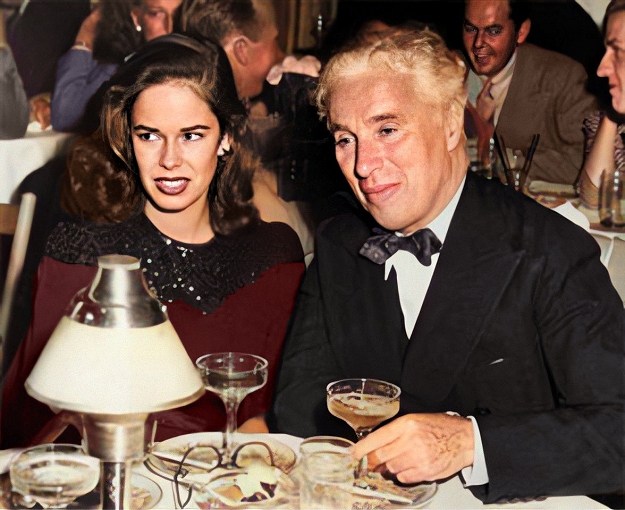 |
Yet by the time of even the first trial, Charlie seemed less troubled and more settled than ever before. He had finally found the equal of his first love, Hetty Kelly, in the person of Oona O'Neill, the daughter of famed playwright Eugene O'Neill. She had come from New York to California at age 17 to try and reconnect with her estranged father, a relationship that did not work out well. Oona also wanted to try her luck in Hollywood. As it happened, Charlie was looking for a replacement for Barry in the fall of 1942 for an upcoming film project, Shadow and Substance. When he first tried her out he deemed the girl too young for the part. However, she immediately took to Charlie and persisted in trying to convince him to use her. Within a short while, they became romantically involved and the film was put aside. Chaplin was reluctant to move forward with the relationship, but Oona pursued it, winning him over. They were married in Santa Barbara, California, on June 16, 1943. Immediately the press added another marriage to an 18-year-old to the list of supposed infractions committed by the aging star, which did not help with the first Barry trial soon to be underway.
Feeling that his words might have some sway still for fans, and even the governments of the United States and Great Britain, Charlie became vocal in late 1942, hoping to help fight the war with ideas. Among those was a secondary front to the east of the Axis of Germany and surrounding nations, which meant forming an alliance with the Soviet Union. While a combination of strategic air power and some cooperation with the USSR ultimately helped the Allies win the fight in the European and African theaters,
there were many who saw Chaplin's ideas as a step towards aligning with communists, and his words on this topic would come back to assault him within a few years. Charlie, now engrossed in the Barry trials and working up his next movie project in 1944, finally backed down from voicing this idea further. On July 31 of that year, his third child and first daughter was born, Geraldine Leigh Chaplin.
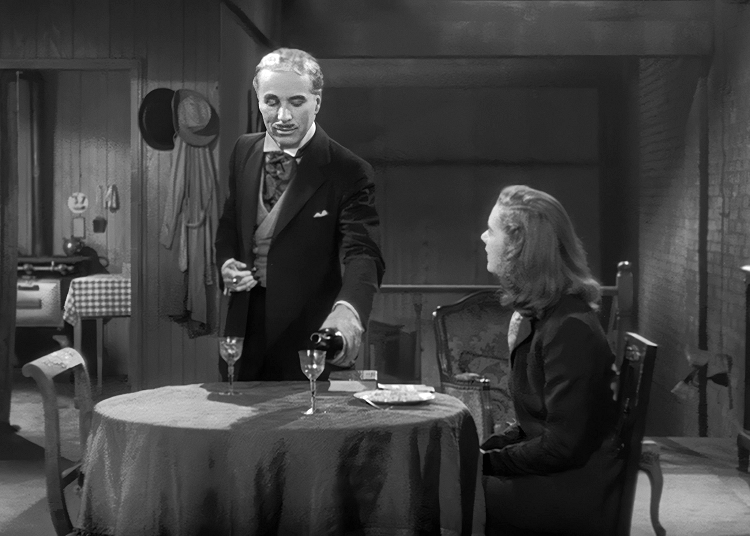 |
Knowing that he could no longer get away with making a silent film, and having ostensibly given the tramp his last hurrah, disguised to some degree as the barber in The Great Dictator, Charlie knew that he would have to create an entirely new character for himself if he were to appear again on screen. That was the project that had been brewing since 1941. Orson Welles had learned of the execution in 1922 of Henri Désiré Landru, who had murdered ten or more women, two dogs, and one boy. Having finished his legendary but controversial Citizen Kane, Welles developed a story that had a similar character marrying women and killing them for their money in order to support his primary family. He thought of Chaplin for the part and had approached him. Chaplin was enthusiastic about the story, but not about being directed by somebody else. He wanted to take over the project, so for $10,000 and a guaranteed screen credit, "Based on an idea by Orson Welles," it became a Chaplin property.
While the Barry-related trials and the war both caused him to delay the project, Charlie's real life courtroom drama helped him create the ending for the story in which he would play the title character, Monsieur Verdoux. Even though it was finally written fairly quickly, there were troubles with the script approval in 1946 when he presented it to the Breen Office, the association responsible for monitoring and enforcing moral codes in motion pictures displayed in the United States. In one scene where Verdoux comes close to poisoning a girl just out of prison, in her original guise she had been arrested for prostitution. In a movie about a serial killer this was oddly unacceptable, so her crime was changed to theft. He also had to remove any suggestion that he was sharing a bed with any woman in his life, and "come to bed" in one scene had to be altered to "go to bed." There were few other alterations, and the production proceeded, although stiltingly.
At this time Charlie was involved many days with the final Barry trial, the second plagiarism trial for Modern Times, the plagiarism trial for The Great Dictator, composing themes for the film, and engaging in actual production.
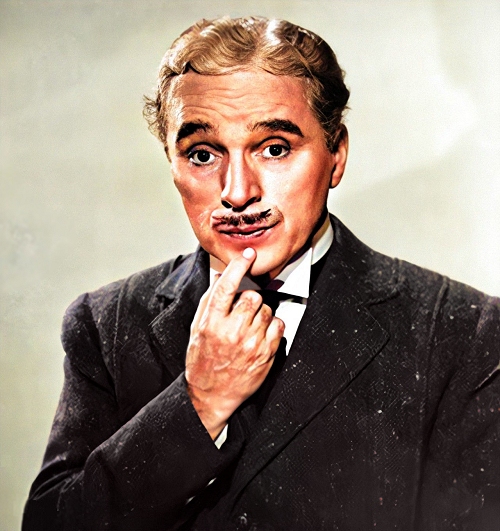 |
Chaplin's score for Monsieur Verdoux, arranged and directed by Rudolph Schrager, is much sparser than those for the previous three films, in part because there is so much dialog. However, in many scenes the combination of camera work, lighting and use of the score were at the same level in many regards as the films of the famous suspense director Alfred Hitchcock. There were repeated motifs, such as the locomotive theme for Verdoux's frequent train trips throughout France, and a lot of use of the oboe either alone or mixed with other instruments in unaccompanied monophonic lines, often introducing a new scenario with Verdoux. His use of underscore in a scene with a young woman on who he was going to test a type of poison and changes his mind signals methods that would become common in the 1950s, withholding all background sound until the moment of danger, then retraction from his plan occurs.
The ongoing court battles with Barry helped motivate Chaplin for his somewhat controversial courtroom speech. Even though it is set in 1937, he gives a 1947 view of the world, pointing out that individuals who kill in small numbers are amateurs in comparison to governments who are able to render mass murders with great efficiency through warfare without themselves being held accountable. "Numbers sanctify," he tells a reporter. This was another astute yet incendiary phrase that would further alienate Chaplin from the public. Indeed, when the film came out in April, Charles had no delusions about what the press was most interested in. Resigned to not talking about the movie, he was relentlessly questioned about the trials, tax issues, and his refusal to become an American citizen. Most critics were also down on Chaplin's performance, some saying he was better in pantomime than when opening his mouth. There were, of course, his ardent supporters, but Monsieur Verdoux was a box office disappointment, in part because many theaters refused to exhibit it given the growing anti-Chaplin sentiment in the United States.
In spite of all these events, Chaplin's screenplay was nominated for an Oscar™ for best writing. When it was exhibited again in 1964 as part of a New York City Chaplin Film Festival, it was the biggest hit of that festival, raking in enormous sums for a single theater.
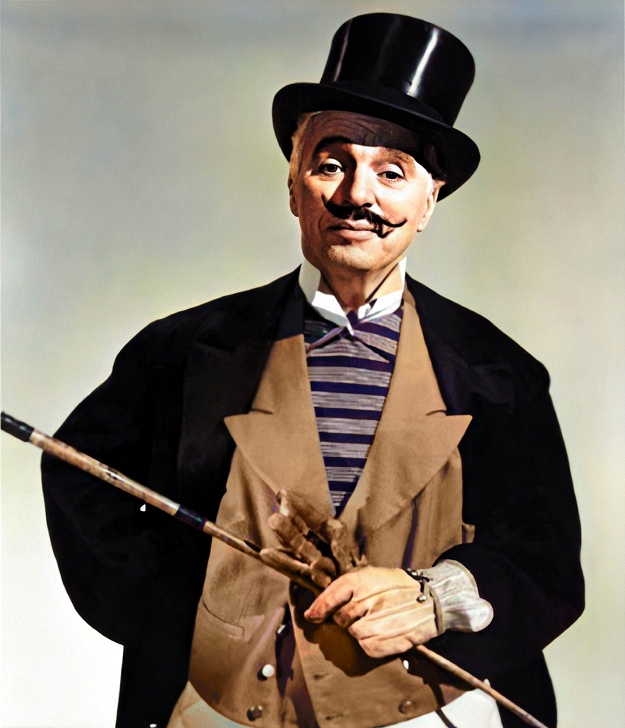 |
When the trials were over, Chaplin moved ahead with his life as best he could, albeit now under even more public and Federal Government scrutiny. In 1946 he had a second child with Oona, and was also still involved in the lives of Charlie Jr. and Sydney. After another break of a couple of years, he set his sights on what many historians have viewed variously as either an autobiographical story or in some cases one of self-pity for his plight. It was also came with a new set of creative challenges.
Limelight was the story of a once-famous stage clown comedian now in his decline, based on real-life people Charlie had observed going through similar situations. In particular were a Spanish clown named Marceline who he had worked with on London stages when he was young, and Frank Tinney, a comedian who had worked in black-face when it was still in vogue. One can't help but draw some comparisons to Chaplin's career as well, although realistically it had not gone into the same unfortunate state, and he was hardly impoverished. It took him over two years to develop the script, initially as an unpublished novel titled Footlights, and the music to go with it. He settled on two main characters, one the aging comedian Calvero, and another a stage dancer, Terry, based on Hannah Chaplin and Hetty, who was dealing with her own handicaps including having been literally paralyzed by fear. Much of the script was based on back story that Chaplin developed in order to flesh out the characters, and even though it is not shown in the film, the references alone are apparent throughout.
Of some importance to note are four of the actors in the film besides Chaplin himself. One was his second son, Sydney, who played a secondary younger male lead. Another was his older half brother Wheeler Dryden, making this more of a family affair.
Claire Bloom starred as Terry, although she was doubled by Oona in a couple of scenes, and by New York Ballet star Melissa Hayden for an extended ballet sequence. The most welcome inclusion was that of his old slapstick rival Buster Keaton, who after several difficult years recovering from career mishaps and alcoholism was starting on his second rise to fame.
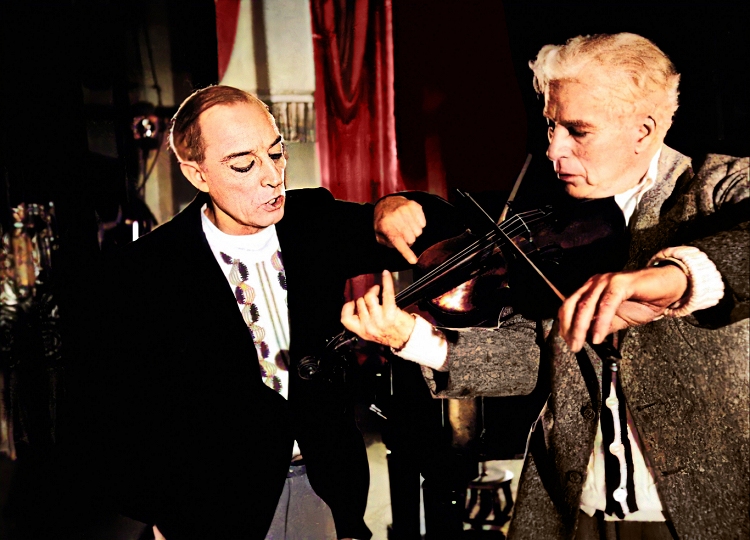 |
To this day there are aspects of Keaton's inclusion in the film that are still points of controversy among historians. He played in an extended scene with Chaplin near the end of the film where they engage in a slapstick routine involving a pianist and violinist. It has long been reported that Keaton may have actually upstaged Chaplin when they shot the routine, and most of his best work ended up excised from the final product. However, it should also be considered that the film was already relatively long, and some may have been left out due to time considerations, and the rest merely to fit the story line better in favor of Calvero. Their memories of this event are quite different. Keaton claims it was delightful and that he would have worked with Chaplin for nothing. Charlie made no mention of Keaton's involvement in his later books.
With a relatively tight shooting schedule, another aspect that had to be worked out in advance was the music for the ballet sequence, which required both composing and recording it. Charlie ended up composing a 25 minute ballet, although it was extensively reduced in the final cut. With the help of Ray Rasch and Larry Russell, he completed one of his finest scores yet. In particular, the haunting main love theme known as Terry's Theme is still regarded to be as venerable as Smile, and was published separately as Eternally. He also dug into his past of ragtime tunes and English music hall traditions, coming up with original tunes that echoed both quite effectively. It would eventually yield him another Oscar™, but that would have to wait.
Limelight was Chaplin's final United States film. Trouble had been brewing in Hollywood and Washington as more information emerged, not all of it genuine, about Charlie's communist sympathies.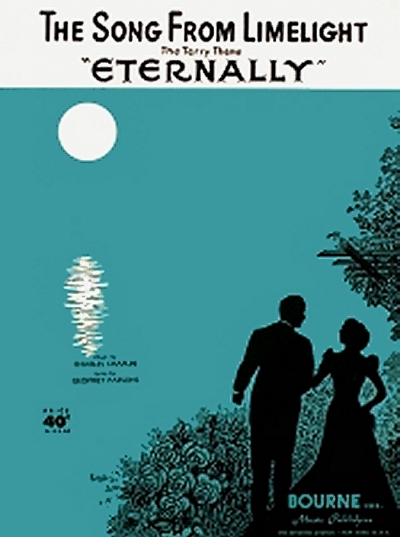 Even though he was now in a very stable marriage that would last for 34 years to his death and produce eight children, the family that Chaplin had long desired, his past affairs were being brought up more frequently in a challenge to both his political and moral turpitude. In July it was announced that he was being investigated by and would be subject to a subpoena to appear in front of the House Un-American Activities Committee to answer charges he was promoting communist causes in Hollywood and beyond. He later wrote that "Although I am not a Communist I refused to fall in line by hating them." There was a call in Congress to commence with deportation proceedings during the height of the Red Scare in 1952. While it did not make it to the stage of deportation, Chaplin did help them out to some degree by leaving the country, albeit not to relocate.
Even though he was now in a very stable marriage that would last for 34 years to his death and produce eight children, the family that Chaplin had long desired, his past affairs were being brought up more frequently in a challenge to both his political and moral turpitude. In July it was announced that he was being investigated by and would be subject to a subpoena to appear in front of the House Un-American Activities Committee to answer charges he was promoting communist causes in Hollywood and beyond. He later wrote that "Although I am not a Communist I refused to fall in line by hating them." There was a call in Congress to commence with deportation proceedings during the height of the Red Scare in 1952. While it did not make it to the stage of deportation, Chaplin did help them out to some degree by leaving the country, albeit not to relocate.
 Even though he was now in a very stable marriage that would last for 34 years to his death and produce eight children, the family that Chaplin had long desired, his past affairs were being brought up more frequently in a challenge to both his political and moral turpitude. In July it was announced that he was being investigated by and would be subject to a subpoena to appear in front of the House Un-American Activities Committee to answer charges he was promoting communist causes in Hollywood and beyond. He later wrote that "Although I am not a Communist I refused to fall in line by hating them." There was a call in Congress to commence with deportation proceedings during the height of the Red Scare in 1952. While it did not make it to the stage of deportation, Chaplin did help them out to some degree by leaving the country, albeit not to relocate.
Even though he was now in a very stable marriage that would last for 34 years to his death and produce eight children, the family that Chaplin had long desired, his past affairs were being brought up more frequently in a challenge to both his political and moral turpitude. In July it was announced that he was being investigated by and would be subject to a subpoena to appear in front of the House Un-American Activities Committee to answer charges he was promoting communist causes in Hollywood and beyond. He later wrote that "Although I am not a Communist I refused to fall in line by hating them." There was a call in Congress to commence with deportation proceedings during the height of the Red Scare in 1952. While it did not make it to the stage of deportation, Chaplin did help them out to some degree by leaving the country, albeit not to relocate.In the long run it is still unclear what person in what government agency pounded in the final nail concerning his rights in the United States. While J. Edgar Hoover has long been suspect, Hedda Hopper had used her voice in the Hollywood gossip columns to turn public sentiment against Chaplin, also accusing him of communism. Some of the most credible speculation is that the Department of Defense, more so than the State Department, saw Chaplin as a threat through his potential sway over some of his more loyal fans in Hollywood and Washington. Chaplin left the United States for the British premiere of Limelight in early October, 1952 aboard the luxurious Queen Elizabeth. Almost as soon as he was gone, the Immigration and Naturalization Service through attorney general James McGranery revoked the visa of the country's most famous resident alien, and he would be denied re-entry into the country in which he had spent four decades setting the standards for film comedy, directing, and musical scoring, as well as contributing significantly to aspects of American life.
In reality, Chaplin could have returned, but before he would have been able to fully gain reentry, he would have had to appear before an INS board of inquiry to answer as to why he should be allowed back in. It was later revealed that the INS did not really have enough cause to ban him from coming back. When interviewed in London about his plight, he responded with a quote by a famous American figure: "As the late Calvin Coolidge said when he terminated his presidency and was embarking to go home, and waylaid by one of the pressmen who said, 'Mr. President, won't you say a few farewell words to the American people?,' he said 'Yes, goodbye!'" The American premiere of Limelight would be poorly attended, and due to the current sentiment about its star following his exile, would be shown on very few screens. As it would not last in Los Angeles for even a week, it was not eligible for Oscar™ contention. In hindsight this was probably a blessing for the comedian. In a very short time all of his films were banned in the United States, although this short-sighted way of thinking would not last very long, and before the 1950s were out Chaplin films would again appear on television and in selected theaters. But Chaplin himself would not be heard from in the United States for nearly two decades.
Exile and Reinvention
After having toured England and part of Europe with Oona and his four children, Charlie briefly considered stating his case and renewing his U.S. visa. He later recalled "that I was fed up with America's insults and moral pomposity, and that the whole subject was damned boring." He finally reconciled that this would be a fruitless endeavor, and made his reasons known publicly: "Since the end of the last World War, I have been the object of lies and propaganda by powerful reactionary groups who, by their influence and by the aid of America's yellow press, have created an unhealthy atmosphere in which liberal-minded individuals can be singled out and persecuted.
Under these conditions I find it virtually impossible to continue my motion-picture work, and I have therefore given up my residence in the United States" In this regard, his exile was actually self-imposed, a fact that was often misunderstood by most Americans during the ensuing decades. In early 1953, Charlie and Oona then established their family in a villa in the town of Corsier-sur-Vevey, Switzerland, the home of Nestlé Chocolate on the north shore of Lake Geneva. He would live on an estate there for the remainder of his life, around 24 years. He surrendered his U.S. visa in Geneva.
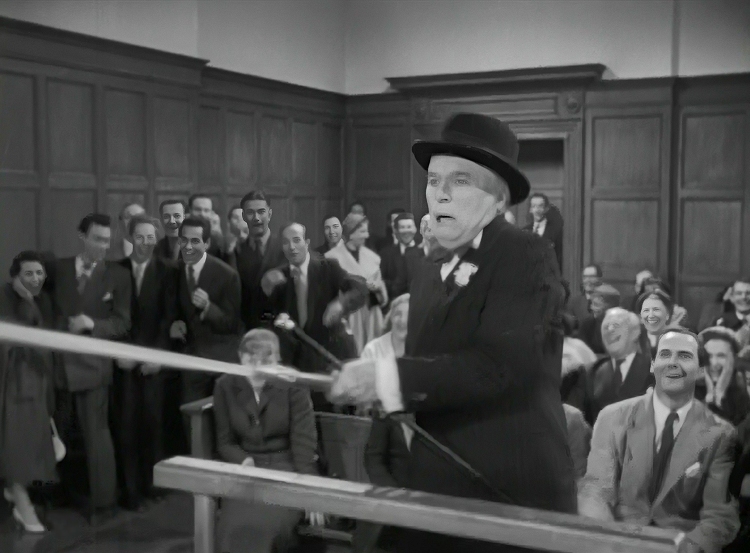 |
Oona returned to the United States alone to wrap up their affairs there. This included packing everything from their home and getting it sold, gathering all of the materials, including film negatives, from the studio, and taking care of other business affairs and transfers. Even though it was known she was in the country, something that made Charlie very nervous, Oona was not stopped or questioned on her trip, even though most other Chaplin associates were still in the hot seat. When she returned the Chaplins had a special film vault installed in their home, and his precious life's work was safely stored for later disposition or distribution. The world was thinking quite differently about Charlie now, and while there were detractors in the United States he still had many supporters there and in his home country of England. While the question of his receiving knighthood from the British Empire was again raised in 1956, it was denied once more due to what the British Foreign Office cited as concerns over his moral behavior. In short, it was still too controversial a move at that time. Oona eventually gave up her American citizenship for that of Switzerland, but was still allowed to return to the U.S. for family matters.
Even away from Hollywood, Chaplin found that there was no need to cease his motion-picture work, and set out to make not just a film but, in spite of his protestations to the contrary, a clear political statement on both his expulsion and the paranoid political climate of the United States in the 1950s. Hampered by not having his own studio, he now had to plan as much as possible in advance to make the best use of locations and rented facilities in order to maximize his investment. The story of A King in New York revolves around the congressional interrogation of a young boy, played by his son Michael who was ten-years-old. Under pressure he names the political affiliations and friends of his allegedly communist parents. One of those was King Igor Shahdov, played by Chaplin, who had been bilked of his funds by his own Prime Minister and had escaped to New York City after a revolution in his country. While campaigning for the use of peaceful and efficient nuclear power, he inadvertently becomes a television icon in commercials, which he acts in to earn money for his cause.
Grilled by McCarthy and the House Un-American Activities Committee, he is exonerated and retreats to Paris. There he welcomes the child and his parents and hopes to enlighten them to a new way of thinking.
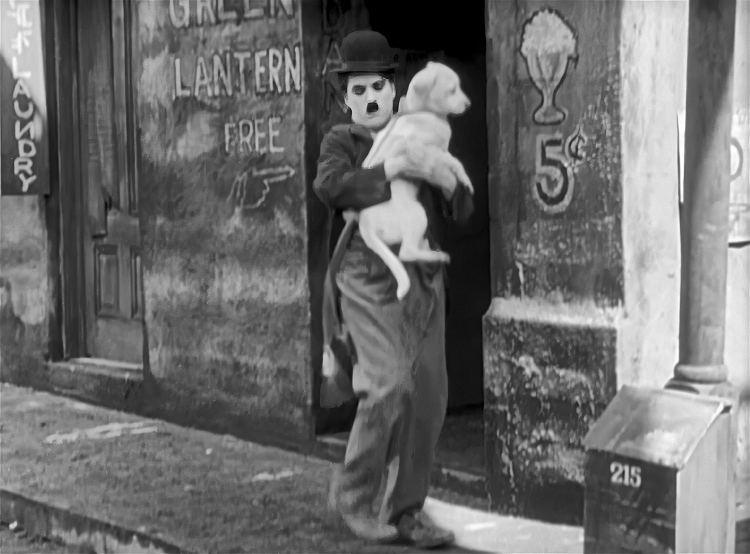 |
The film takes obvious issue with the HUAC, new revolutions in film such as widescreen formats, the pitfalls and audacious effects of celebrity, television as a medium and its commercialism, and popular music. For the latter, Chaplin composed some pop music with non-clever rhymes to make his point. Unfortunately, given his time constraints, the music, cinematography, and even some of the writing have historically been scrutinized by film historians as shoddy or in need of editing and refinement. In addition, London was not an ideal stand-in for New York City, but he could not film on location for obvious reasons. A King in New York opened in virtually all major movie markets outside of the United States in September 1957, and did well enough that Chaplin was able to recoup his costs. It was largely ignored, however, in the United States. However, two other projects, one of them totally out of the hands of Chaplin, would help to start the long healing process.
In 1957. around the same time as the release of A King in New York, American film entrepreneur Robert Youngson compiled a documentary on silent film comedians. It included clips of the Sennett studio in action extracted from The Hollywood Kid, and had incessant narration throughout. The orchestrated music, mostly classical and largely culled from Chopin, has been viewed as not entirely appropriate, especially with some of the whimsical sound effects thrown in for fun. Still, The Golden Age of Comedy was well received and critically acclaimed, in spite of the obvious absence of Chaplin, Keaton and the third major comic genius, Harold Lloyd. In an effort to cash in on the film's success, and perhaps to rectify the omission of his first compilation, Youngson released When Comedy Was King in late 1959. While the inclusion of Chaplin and Keaton rectified their absence from the first film, Youngson evidently felt it necessary to temper Charlie's films with statements like "The young Charlie Chaplin, swept so quickly to fame, was to become a figure of controversy," and "But that was before the troubled times..." The second film, less weighed down by narration and abrupt pacing, did even better than the first.
Whether Charlie was emboldened by the results of The Golden Age of Comedy or was hoping to capitalize on its reception and improve on its faults is unclear. However, in 1959 he continued where he had left off with his redux of The Gold Rush.
Since his days at First National and A Dog's Life, Chaplin had full ownership of his film products, so naturally had access to and control of all the original 35mm negative elements. He also had the Essanay negatives, but these were inexplicably destroyed at Chaplin's request instead of being shipped to Europe. He took three of his First National Films, A Dog's Life, Shoulder Arms and The Pilgrim, re-edited them slightly, added footage from How to Make a Movie which showed off his new studio, and packaged them as The Chaplin Revue in 1959. His friend, critic James Agee, also had a role in prompting the film, although his vision was to put the tramp in a more contemporary environment, which Chaplin quickly rejected.
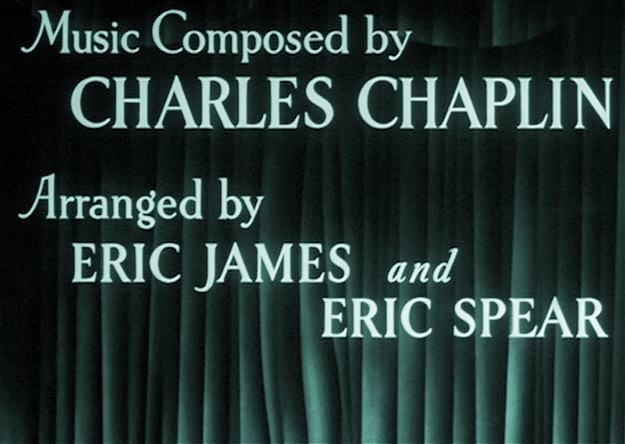 |
This new release of his First National material was accompanied by minimally narrated introductions and a full score composed by Chaplin, some of it using musical elements from his previous film scores. Unlike the Youngson productions, which tried to retrofit classical and old popular tunes to the action, Charlie chose to underscore the emotion of each scene, with very few synchronized effects (such as the beating of a bass drum by a dog's tail). The recurring theme for the Green Lantern Inn became The Green Lantern Rag, an authentic ragtime piece that when fully assembled represents a three section rag. In A Dog's Life for a scene where Edna Purviance is singing a weepy ballad on stage, instead of trying to retrofit a known piece underneath her performance, he used a bowed saw instead to substitute as a forlorn human voice. Shoulder Arms used a more militaristic theme, yet it too played upon emotions more than comedy. For The Pilgrim, which features an escaped convict dressed in a Quaker pastor's outfit on his way from New York to Texas where he is mistaken as a real pastor, Charlie wrote a real authentic western tune, Bound for Texas, employing British singer and Decca artist Matt Monro (later known for recording Born Free) to don his best cowboy voice for the song.
Running two hours, The Chaplin Revue was released in September 1959 in England, and other parts of Europe over the next several months.
The Chaplin Revue Copies of it made it into the United States where it received fairly good reviews by those who dared to do so. Some historians have derided the editing, in which some scenes were stretched and re-paced to accommodate the music, and a number of frames ere excised for the same reason. However, it has stood the test of time. With the McCarthy era now fading into the background, the film's popularity signaled the first rumblings of a Chaplin revival in the U.S. was the first film in which Charlie engaged Eric James as his orchestral arranger, along with Eric Spear and conductor Eric Rogers. Coincidentally, one of the sound engineers was named Eric Stockl.
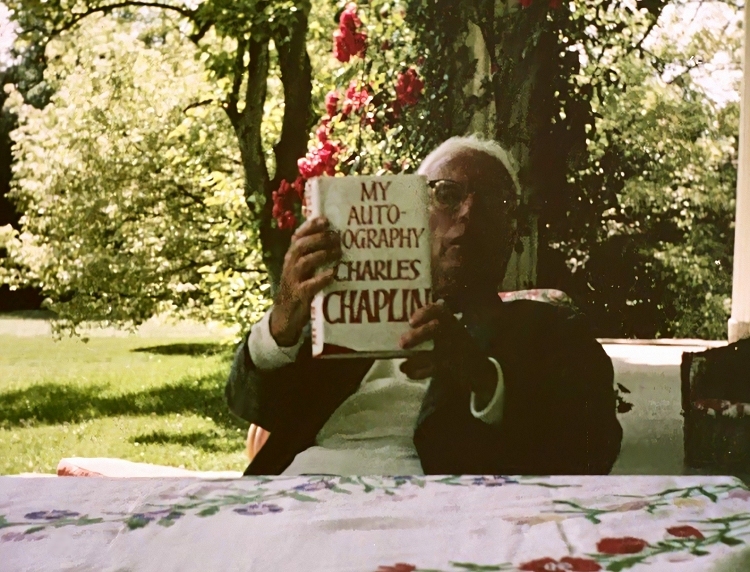 |
In the early 1960s, Charlie took time out to compile a somewhat sanitized but otherwise selectively thorough autobiography. My Life would be published in 1964, followed by three other books over the next few years. He focused largely on life with Oona and his children in Switzerland. Home movies show an attentive and fun-loving family man who treasured his eight offspring and adored his strong and devoted wife. Among the visitors to the Chaplin estate in Vevey were friends of Oona, Walter and Carol Matthau. Carol and Oona had gone to school together and maintained their friendship. Walter would later play a role in Chaplin's reacceptance in the U.S. Sydney and his second wife, Henriette, were also visitors until Sydney's death in 1965. In 1962 he was awarded an honorary doctorate degree by Oxford University, and in 1965, shared half of the Erasmus prize with another famous director, Ingmar Bergman, amounting to five million French francs.
Charlie had used his wife in children at various times in films, and at home the family made their own mini comedies or dramas. A couple of them went a bit further in their acting ambitions. His second son, Sydney, went into films after World War II, winning a Tony Award™ in 1957 for Bells are Ringing, and a nomination in 1964 for his performance as gambler Nicky Arnstein opposite Barbara Streisand in Funny Girl. Charlie's oldest daughter, Geraldine, had been seen briefly in Limelight. After she gave up the idea of a career in ballet she received training in acting. Her first major role was as Tonya Gromeko in the David Lean epic Doctor Zhivago, which earned her a Golden Globe™ nomination.
Fluent also in French and Spanish, she acted in films aimed at many different markets, including Robert Altman's Nashville in 1975 which earned her another Golden Globe™ nomination. Michael (1946), Josephine (1949) and Victoria (1951), all American born, also entered into film acting in some capacity.
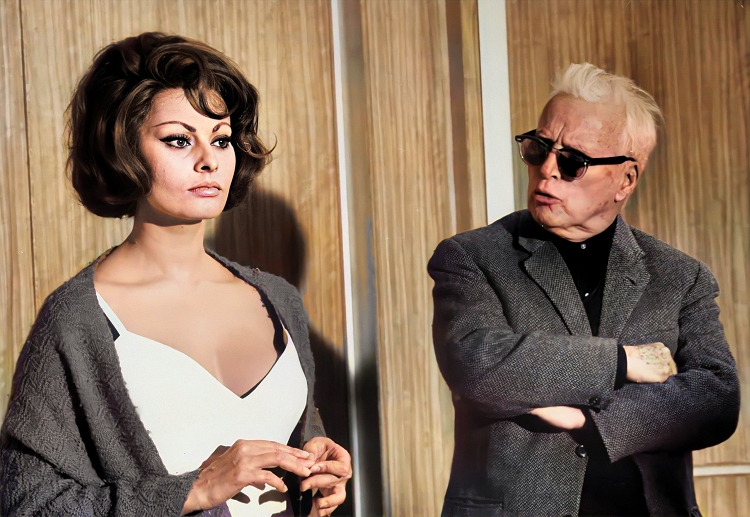 |
Chaplin wanted to prove that he had at least one more good film in him, and in mid-1965 undertook his final production, A Countess from Hong Kong. He wrote the comedy as well, based on an idea called Stowaway which he had intended for Paulette Goddard in the late 1930s. It was about an American ambassador-designate to Saudi Arabia who makes his way to Hong Kong while finishing up a world tour. There he encounters a Russian countess who sneaks on board a luxury liner and into his cabin in order to escape a life of forced prostitution. A farce is in the works when the ambassador's wife boards in Hawaii. Included in the cast were three of his daughters in walk-ons. Sydney had a moderately important lead role and Charlie did a walk-on as a ship's steward. The stars were Marlon Brando and Sophia Loren. A Countess from Hong Kong was Chaplin's first and only film in color and widescreen. Surprisingly he received support from Universal Studios in California, who had just entered the British film market at Pinewood Studios.
The expensive enterprise was not surprisingly plagued by problems on the set at Pinewood. Chaplin broke his ankle during a walk, the first serious injury he had ever sustained in his long career. Brando, who was second choice to Rex Harrison who had demurred from the part, was very much an admirer of Chaplin, but did not act this way during the filming and was difficult both on and off the set. Both later made it clear that the experience of working together was quite unpleasant. The same lack of chemistry and cooperation existed between Loren and Brando. There were also issues with the lenses used on the cameras, and problems with editing.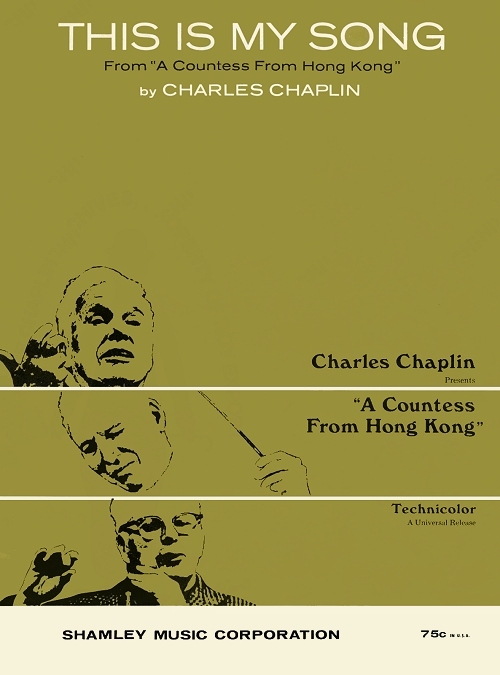 The music was perhaps one of the best aspects of the production, as Charlie composed no less than fifteen themes, and used a couple of other classical works. One of his pieces, titled This is My Song, was covered by popular singer Petula Clark shortly after the release of the film. Chaplin did not care for her rendition, but it went to number one on the charts and turned out to be the only bright spot of a dark period.
The music was perhaps one of the best aspects of the production, as Charlie composed no less than fifteen themes, and used a couple of other classical works. One of his pieces, titled This is My Song, was covered by popular singer Petula Clark shortly after the release of the film. Chaplin did not care for her rendition, but it went to number one on the charts and turned out to be the only bright spot of a dark period.
 The music was perhaps one of the best aspects of the production, as Charlie composed no less than fifteen themes, and used a couple of other classical works. One of his pieces, titled This is My Song, was covered by popular singer Petula Clark shortly after the release of the film. Chaplin did not care for her rendition, but it went to number one on the charts and turned out to be the only bright spot of a dark period.
The music was perhaps one of the best aspects of the production, as Charlie composed no less than fifteen themes, and used a couple of other classical works. One of his pieces, titled This is My Song, was covered by popular singer Petula Clark shortly after the release of the film. Chaplin did not care for her rendition, but it went to number one on the charts and turned out to be the only bright spot of a dark period.When A Countess from Hong Kong was released in January 1967, there were projection problems at the London premiere in which the wrong lens was used and the film was displayed at an incorrect aspect ratio, setting the dismal tone for what was to come. Critical reviews on the editing and the partially spherical presentation of the premiere were rather abysmal. The British and European moviegoers took the critics at their word, and the $3.5 million film ended up recovering only half of the production costs. The lack of American distribution further increased any hopes for success. In spite of the support of a minority of critics, his film was regarded as a box office failure. Universal removed fifteen minutes from the original cut for a revamped release, but it did not do any better, and Chaplin felt that the cuts ruined the overall production. Charlie went into a deep depression that would last for some time.
Still interested in work in spite of the major setback, Chaplin revisited another film in 1968 that had not even been mentioned in his 1964 autobiography in spite of it being responsible for his first Oscar™. He resurrected his 1928 motion picture The Circus and wrote a fresh score for it which included a theme song, Swing, Little Girl. The piece was used for the title sequence. To further codify his involvement with the music and at the insistence of Eric James, who was again acting as arranger, Charlie actually sang the title sing at age 79, giving him a bittersweet involvement with this difficult project some four decades after it had been first completed. His next act would force him for the first time to contend with a soundtrack at the same time he was making a film. In his book My Life in Pictures, written in 1974, Charlie mentioned that he had been working on one more film project titled The Freak which was to star his daughter Victoria. Costumes were made as were film tests, but the production never got off the ground.
Now resigned to a retirement driven more by public sentiment than personal ambition, Charles retreated into his estate at Vevey, and into himself. He remained devoted to Oona and his children, but did not emerge publicly for nearly four years. Charlie did not know it yet, but there was one final act left that involved healing and his legacy, some of which would equal the pathos and joy found coexisting so effectively in his earliest films.
The Road Back Home
The Chaplin family became involved in Charlie's love of music. He had a collection of records and reel-to-reel tapes of classical music. They would often gather together in the evenings and listen to one or another symphonic work or piano sonata in a house only lit by candles. Discussions of the music would often ensue as well.
Some of the influence of this practice showed up increasingly in Chaplin's scores as his musical vocabulary increased. He was better equipped to suggest instrumental timbres and combinations, cadences, and other technical facets of the score which Eric was able to translate. There are still hours of audio tape in the family collection that have Charlie working on melodies on the piano, humming at times to hone in on a certain melodic fluidity. He had said that even if he could not remember the melodic line as a series of notes, he could remember the physical patterns on the piano keys.
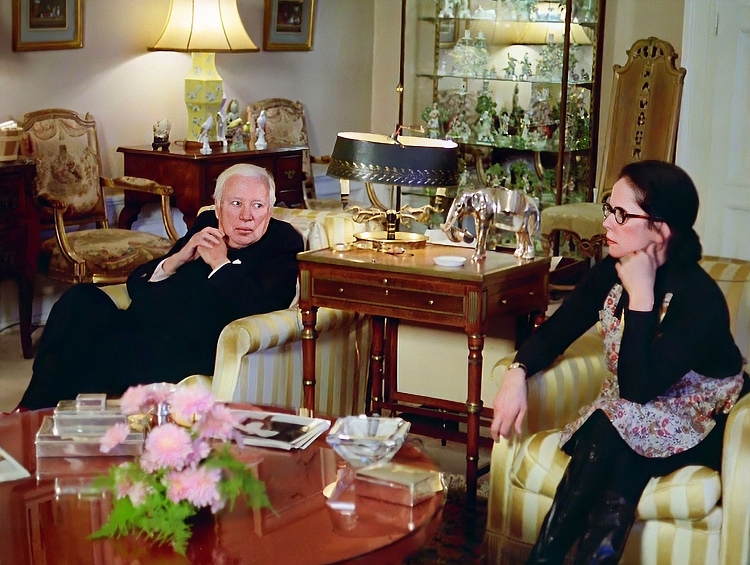 |
Throughout his life Chaplin had befriended many top musicians and composers, some as friends and some as acquaintances. They included Sergei Rachmaninov, Igor Stravinsky, Ignace Jan Paderewski, Vladimir Horowitz, Victor Borge, Hanns Eisler and Arnold Schoenberg. Others in the classical world continued to visit him from time to time in Vevey, and he would hold miniature concerts with them for family and friends. It may never be known what kind of influence they had on the later film scores that Chaplin composed, but it can be ascertained that there was some discussion from time to time on his music that may have included advice, solicited being the most likely type.
After taking a break for a couple of years, Chaplin decided to continue his project for completion of composed and recorded scores for his earlier films, this time with much less re-editing involved. In 1971, with help from Eric James, he managed to finish The Idle Class and his early masterpiece of pathos, The Kid. He also worked on some more potential book material as well, making sure to leave a more detailed accounting of his life as an artist in films.
In the interim back in the United States, silent films, which sometimes started out as filler material for shows on independent and public television stations, were being discovered by a new generation.
There were still issues with their presentation as most television stations were not able to compensate for the slower frame rates, and many simply used random honky-tonk records as a music track. So the action was sped up and the accompaniment corny. Still, the films of Keaton, Lloyd and Chaplin were now getting noticed again. There had been a Chaplin film festival held in New York in 1964 that featured works from his entire career up through Limelight, and it was popular enough that such events were repeated over the next several years with increasing attendance.
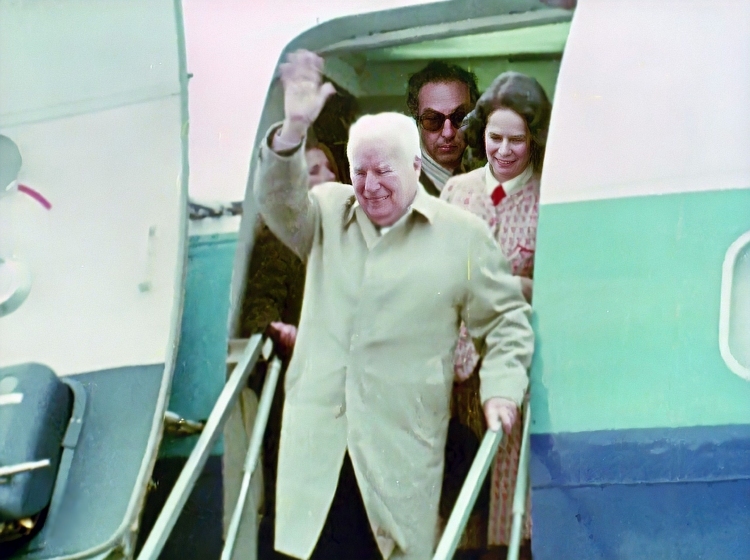 |
In 1971 Mo Rothman acquired distribution rights to Chaplin's films in the United States and was looking to promote then in some way. By this time, with the McCarthy era long gone, a new generation in power in government and entertainment, the focus being largely on the continuing war in Vietnam, expanding musical and creative horizons, more independent film makers, and a second wave of 1900s nostalgia following the widespread honky-tonk craze of the 1950s, it seemed that the time was right for a reconciliation with the exiled comedian. More than a simple apology was clearly in order, and with the cooperation of the United States Government, Hollywood was able to set the stage for perhaps the most emotional moment in the history of the cinema.
In early 1972, through Rothman and Academy member Bert Schneider, a resolution was drafted by the Academy of Motion Picture Arts and Sciences to honor Charles Chaplin with an overdue honorary award to be presented to him in April. Even though Hoover was still running the FBI (he would be dead within a month of the presentation) he did not have the same support as he had in the past concerning such matters. He was not really even a factor in Charlie's return. Oona fully supported and encouraged her husband to make the trip to the country that had thrown him out just less than two decades prior.
Their first stop was in New York where they visited some old friends and saw to a few other business matters. When the Chaplins arrived at the airport in California there were a number of devoted fans there to welcome them. Among them was actor Jackie Coogan who was the star of The Kid (1921) and had also been in A Day's Pleasure two years before that. Even though decades had passed, Charlie recognized him and made his way over the give Coogan a hug. He reportedly whispered to him, "I think I would rather see you than anybody else." One of the people that had hoped to honor Chaplin during his visit was trumpeter Herb Alpert, who along with Jerry Moss had founded A&M Records a decade earlier. They now occupied the old Chaplin studio on La Brea, having converted two sound stages and the pool area to recording studios. In 1984 he had added a mural to one of the large walls depicting Chaplin in a number of his films. However, Charlie wanted to avoid public appearances as much as possible,
and simply arranged to be driven to the gates on Sunday, April 9, so he could reminisce for a moment or two. This incident is also depicted, nearly unnoticed, in the 1992 biopic.
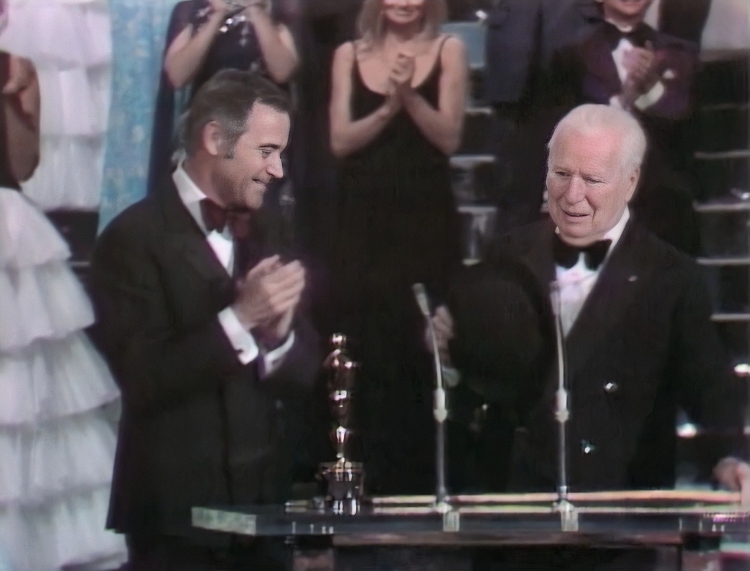 |
On Monday night Charlie Chaplin was escorted into the Dorothy Chandler Pavilion at the Los Angeles Music Center for the 44th Academy Awards Oscar™ ceremony, reportedly uncertain of how he would be received by his peers after such a long absence. Veteran star Betty Grable was also honored that night in her last stage appearance. She would die from cancer within the year. One of the hosts, Jack Lemmon, introduced a montage of several minutes showing some of the best moments of Charlie's work, assembled by no less than Peter Bogdonavich. Then Lemmon announced the lifetime achievement Oscar™ which was presented to Chaplin "for the incalculable effect he has had in making motion pictures the art form of this century." "The 3700 fellow artists of the academy, with pride and affection, present this tribute to one of the immortals among men."
This author, who is the son of a fairly well known character actor (Sam Edwards) remembers the wave of emotion that swept through our Los Angeles home that evening when the aged little tramp slowly walked out on stage to a tumultuous ovation the likes of which had never been heard at an Oscar™ ceremony and has not been repeated since. Even in my early teens I was quite aware of many of Chaplin's films and his importance in comedy, and also was educated on his exile. But nothing could prepare us, or even Charlie, and perhaps even the crowd in the Dorothy Chandler Pavilion, for the reception that one of the most misunderstood and yet revered members of the early days of film would enjoy, especially in the city that he helped to build. The applause lasted more than five minutes, with nobody in particular trying to stop it so the show could go on, because at that moment, that was the show.
Charlie was duly overcome by the reception. After the applause finally subsided and he received his statue he could only utter a few words of thanks to his supporters. "An emotional moment for me, and words seem so futile; so feeble. I can only say thank you for the honor of inviting me here, and... oh, you're wonderful, sweet people. Thank you." Lemmon then handed him a cane and a bowler hat, a trademark of the tramp, and Charlie put it on his head, caused it to pop off, and gave a little impish grin. Jack and all of the honorees serenaded him with Smile as Oona came out. He was still composed enough to point at and publicly acknowledge his long time supporter and best friend, making it clear that she had also made this moment possible. Then he exited the stage, left the building, and returned to his home in Corsier-sur-Vevey, Switzerland, never again to set foot in the United States.
And In The End...
Because of the rules of the Academy of Motion Picture Arts and Sciences, which stated that a film needed to run at least a full consecutive week in a year in Los Angeles and New York to allow voting members a chance to see it,
Limelight had not been eligible in its first run in 1952, pulled before it even got off the ground. However, in the swell of Chaplin nostalgia that was felt throughout the motion picture industry and by Chaplin fans, several of his older films were now being released by Rothman. Among them was Limelight, which finally got its due in the Los Angeles and New York markets. Now eligible due to that technicality (which has since disappeared), Limelight was nominated for and won the Oscar™ for Best Music, Original Dramatic Score at the 45th Academy Awards Ceremony in April 1973. Chaplin was not on hand to retrieve it, but co-writers Raymond Rasch and Larry Russell took the statue which soon found its way to Europe. This was Chaplin's third Oscar™ after several nominations through the years, and the first Oscar™ he won in a competitive category. Given that his first award in 1929 covered a number of categories, he remains the first recipient of Academy Awards honoring at least five different disciplines - directing, writing, producing, acting and composing.
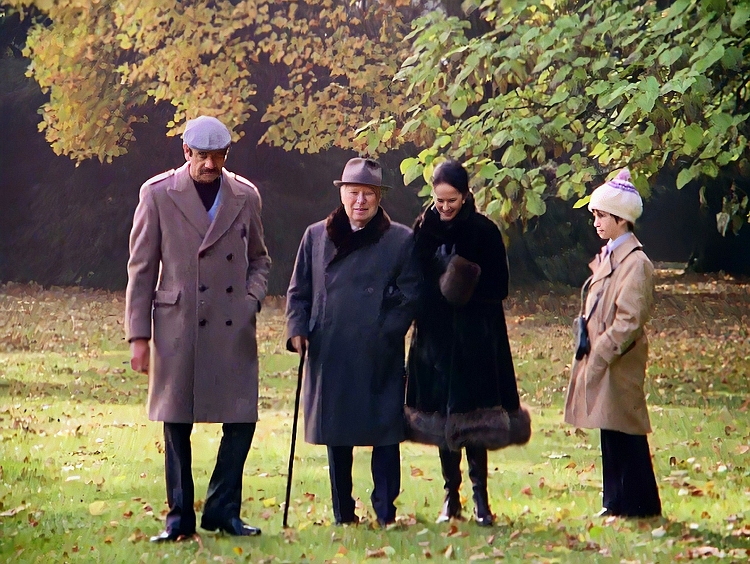 |
Soon after the Chaplins returned to Switzerland, Bogdonavich, who had been a documentary director before his award winning The Last Picture Show, was tapped to interview Charlie for a potential documentary. He sent in a French camera crew headed by Pierre Cottrell. However, most of what was shot turned out to be unusable because Chaplin's mood would change often, and some of his stories lacked the detail or emphasis that the directors were looking for. Director Richard Patterson took over the project and decided to make a film about Charlie's life, using some of the previously shot footage as well as key sequences from Chaplin films to juxtapose with certain elements of his life. Many of the family's 16mm films were also added into the mix. With the assistance of Walter and Carol Matthau, more candid footage was shot in Vevey to fill in the ending.
The Gentleman Tramp, narrated by Walter Matthau included several quotes of Chaplin read by Laurence Olivier. When it was first viewed by Oona, she made several suggestions about scenes or points she thought should be removed from the film. Much of this included the juxtaposition of films with life events. Some of the film was re-edited, but just before the premiere Oona vociferously objected to the fact that not all of her requested alterations had been made, suggesting that the juxtaposed scenes were poor substitutes for actual events in Charlie's life. Her protestations were intended for the most part to properly protect her husband's legacy. Patterson carefully wrote her a letter defending all of his choices and the logic behind them, noting that these were intended as dream sequences of a sort, echoing but not duplicating what was happening in Charlie's life at those particular times. No further objections were lobbied and the film was approved.
The soundtrack used a great deal of Chaplin's own music, some newly recorded. Released initially in selected theaters, a version was also made for television that featured Matthau doing some on camera narration for transitions from commercials. The Gentleman Tramp has long been regarded as a fine and respectful testament to the life of a film genius.
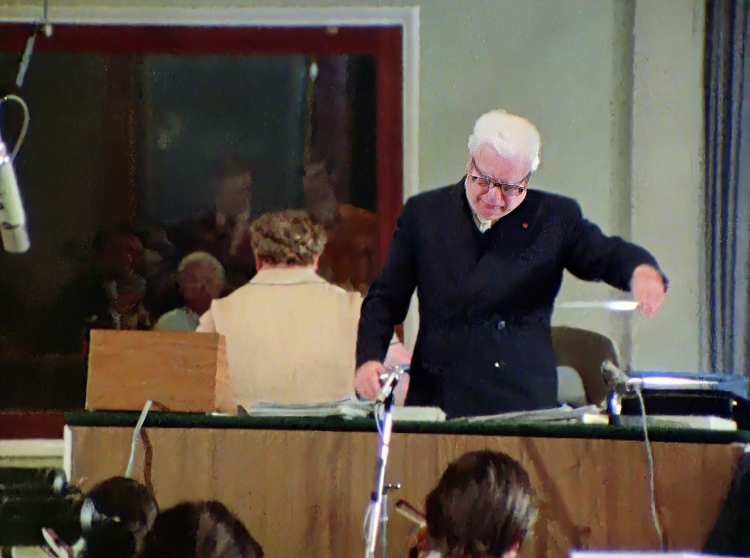 |
During this time, Charlie had gone back in to the recording studio with new scores for his remaining First National films, including Pay Day in 1972, A Day's Pleasure in 1973, Sunnyside in 1974, and his last film scoring session for the long neglected 1923 feature A Woman of Paris in 1976. All told, Chaplin had written scores for no less than 18 of his films, most of them feature length, and out of those several enduring pieces emerged. The longest lasting of those, often played when he was received at various functions, were Eternally from Limelight, Falling Star from The Great Dictator, the main theme from City Lights, and the brilliant Smile. The latter remains his most familiar tune, having been beautifully rendered soon after the lyrics were added by artists as diverse as Nat "King" Cole and Wladziu Valentino Liberace.
That one elusive honor that so many had hoped the British film maker would receive finally was awarded forty-four years after it had first been put forward; a knighthood from the British Empire. On March 4, 1975, Charlie was wheeled into Buckingham palace, just miles from where he had been born and raised, as a subject of the British Empire. The orchestra played his beautiful theme from Limelight as he was brought into the hall. Queen Elizabeth tapped him on each shoulder and hung the KBE (Knight of the British Empire) medallion around his neck before the two briefly chatted. As he left the ceremony, the 75 year old actor who had been so supple and athletic into his early sixties asked that the cameras be stilled as he struggled to get into the limousine. He exited as Sir Charles Spencer Chaplin.
His final two and a half years were spent in declining health at home with Oona and frequent visits from their children and friends. Charlie was becoming frustrated with his increasing inability to communicate, a paramount function in his life, and this may have contributed to his failing condition. Sir Charles Spencer Chaplin, the wayward child of two English music hall singers who ended up leaving an indelible mark on the 20th century, finally succumbed to death, the very thing he had defied so many times during his prime years of acting in his own films, passing in his sleep at 88 years of age on Christmas Day 1977.
Charles was interred near Sydney and Henriette in Corsier-sur-Vevey Cemetery. But was not allowed to rest in peace right away. A group of Swiss Mechanics stole his casket from the grave on March 1, 1978, in an effort to extract a ransom from the grieving family. The Swiss detectives managed to thwart the plot, and by mid-May Chaplin's body had been recovered. Fearing further incidents of this type, the family had him buried in the same plot, but under six feet of concrete. Now his body would rest peacefully while his soul continually entertained all of those who had passed from this world as well.
Oona returned to New York to escape her grief and start a new life. However, her efforts did not carry her far enough, and in the mid-1980s she returned to Vevey and the Chaplin villa, rarely showing herself in public, and reportedly struggling with alcoholism. Although she gained some control over her issues with her family's help, Oona was diagnosed with pancreatic cancer after it was too late to counter it. Charlie's one and only enduring love, Lady Oona O'Neill Chaplin, joined him on September 27, 1991, and is interred next to him in Corsier-sur-Vevey Cemetery.
Coda
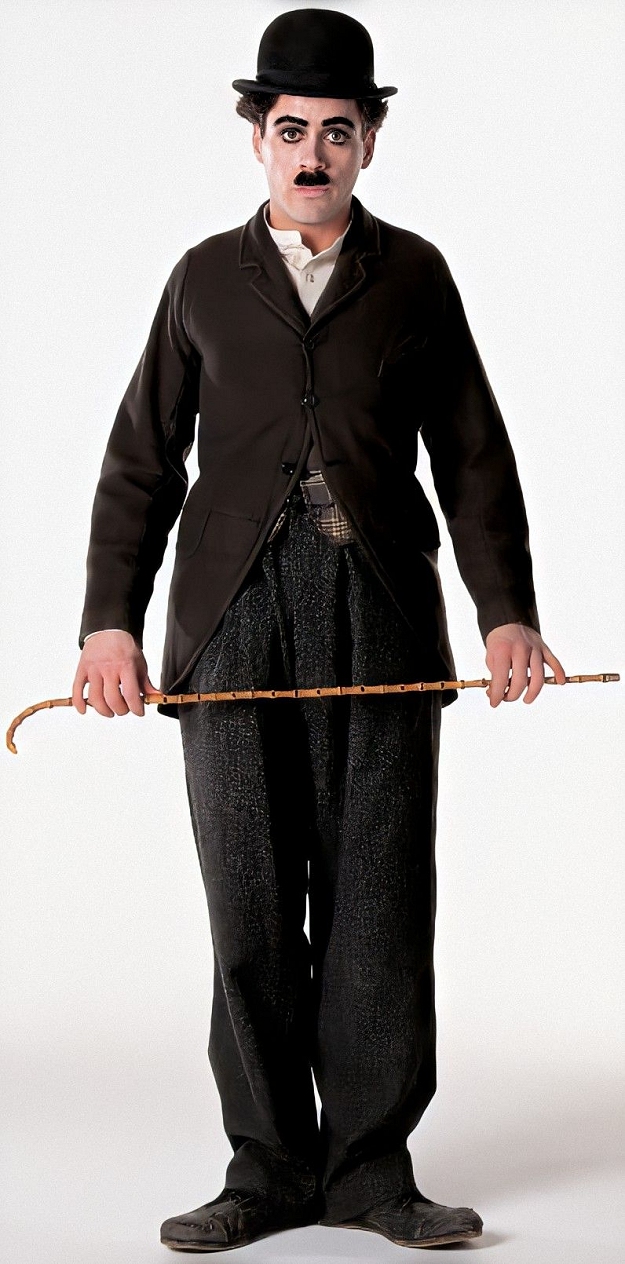 |
In some ways this actually speaks very highly of Chaplin as both a film maker and a musician. The clear intention of music in relation to films for him, going back to when he first distributed cue sheets for The Kid with specific styles of pieces intended for specific scenes, was to enhance or underscore the action on the screen without getting in the way of it. The very word underscore comes from this contention, and is used to denote what some might call background music, even though a true underscore has a much more symbiotic relationship with the other elements of a scene, including sets, lighting, camera angles and, of course, acting. Knowing this, Charles wrote themes from his heart and mind that were suggested as much by the action he saw on the screen, or in some cases envisioned in advance, as much as from his own ideas of what would move an audience without detracting from the story.
Yet it was not until the 1990s that any serious study was done on his scores and compositions, and even in the third decade of the 21st century, many Chaplin fans are still unaware of the sheer volume and quality of the works he composed over a period of sixty years. There are now CDs and music downloads available of Chaplin scores and songs in their original recordings or rendered by any number of popular artists, Smile being the one that tops the list, followed by Eternally. It is hoped by this author that future generations will be more aware of this particular layer of the many talents of Charlie Chaplin, and perhaps find new ways to apply his music to his films, or even as separate entities. There have been several books written on silent films in general and Chaplin and Keaton in particular since their deaths. As might be expected, some of them focus on the visual or comic aspects of these two multi-talented individuals, but at the very least they have instilled interest in new generations of moviemakers and moviegoers, and bring new insight to those of older generations.
Seeing that the time was right, actor and director Sir Richard Attenborough, also a Knight of the British Empire (1976 - now Lord Attenborough), worked to bring his own vision of Chaplin to the screen in 1992. The lead role was played brilliantly by actor Robert Downey, Jr., who in his thirties realized his own struggles with fame and addiction that have since been put behind him and channeled into a highly successful career. Downey, with Attenborough's help, seemed to understand the struggles that often hounded Chaplin, and while it was impossible to encapsulate who he really was in the space of 144 minutes, the pair managed to cover most of the aspects of his life and career, including his musical involvement. One of the more artistic devices Attenborough used was to cast Moira Kelly in the roles of both Hetty Kelly and Oona O'Neill, Charlie's first and last loves. Bringing the story full circle, Chaplin's oldest daughter, Geraldine, was brought on board to play her own grandmother, Hannah Chaplin.
The film was released on Christmas Day, 1992, exactly fifteen years after Chaplin's death. Downey easily snagged a best actor nomination for that year's Academy Awards.
Geraldine Chaplin, along with Downey, was nominated for a Golden Globe™. Many criticized Chaplin for the tepid use of Anthony Hopkins as a fictitious biographer of the tramp, a device which was merely included for narrative flow. But in holding Downey up to Chaplin, they could not overlook the fact that Attenborough had mixed in actual clips from Chaplin films instead of reshooting them, such was his confidence in his star's performance. Ultimately it suffered due to the sheer magnitude of Chaplin himself, further chided for trying to cover too much ground in too short a time. Some of those critiques may be authentic in their collective points, but many Chaplin fans were glad that he was being reintroduced to the world, even with some of his more troublesome flaws clearly intact. Downey also appeared in a documentary on Chaplin produced in 2003.
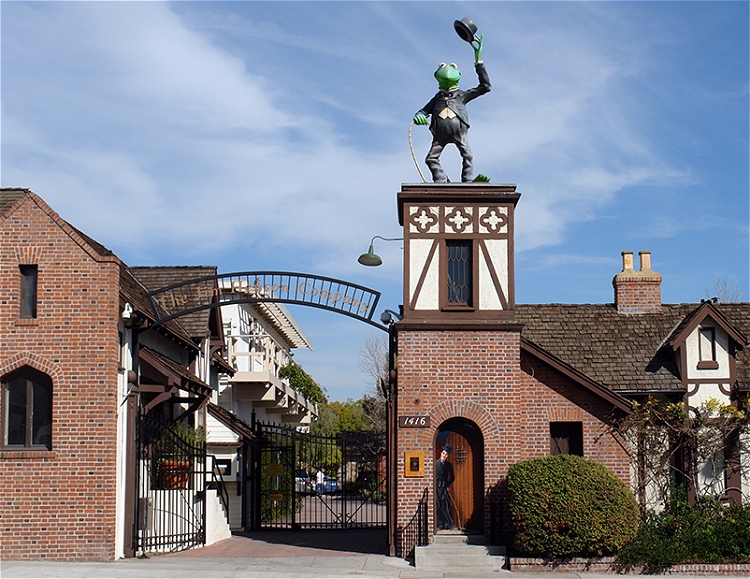 |
Film historian David Shepherd of Kino Films/Image Entertainment, among other historians, has worked tirelessly since the 1980s to find the best film elements of prints from around the world and restore the films, as often as possible, to their original exhibition length. In some cases he had access to original camera negatives, and with these and selectively intelligent scores by a handful of astute musicians around the world, has been able to offer a balanced and even fresh look at Chaplin's early work. All of his films are available on DVD, although some of the DVDs are now out of print. A few of the later films are now available on high definition Blu-Ray format, with more in the near future. One of the best sets from Image Entertainment is of the 12 Mutual Films, which also includes a documentary on Chaplin's Goliath, Eric Campbell, and both versions of The Gentleman Tramp. A great addition in late 2010 was a new restoration of all of the Keystone comedies, with only one known to be missing, and only two from inferior prints. Properly restored and timed by Shepherd, they give an entirely new perspective on Chaplin's earliest forays into film.
The Chaplin family has also made available from the vault in the villa in Vevey all of Charlie's original negatives from 1918 and later. MK2 Editions and Warner Brothers made all of these available on laser disc, then DVD from the late 1990s to the early 2000s. They are also being released on Blu-Ray in the 2020s, and perhaps in 4K one day. Each package contains a number of engaging features and rare footage plus remastered soundtracks of Chaplin's music and even occasional audio tracks. They are consistently introduced by one of Chaplin's later and most respected biographers, David Robinson.
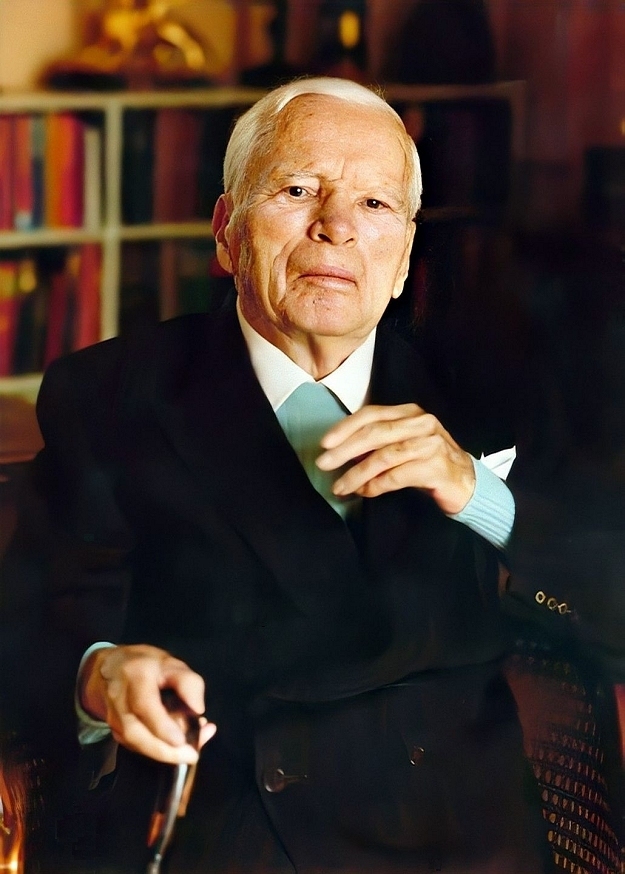 |
Appropriately enough, Charlie's legacy also remains in his La Brea studio in Hollywood. He initially sold it in 1957, nearly five years after he left the country, to a company that leased it out for a few films. In 1959 it was purchased by another brilliant pantomime artist, Red Skelton, who used it for his shows for two seasons. In 1961 the property again changed hands, now owned by CBS who produced a few shows there. They allowed William Hanna and Joseph Barbera, who had established Hanna-Barbera there in 1960, to remain at the studio, making cartoons until 1963. In 1966 CBS sold the property to musician Herb Alpert who by then was becoming a pop icon for his Tijuana Brass recordings, and his partner, Jerry Moss. A&M Records remained there for 33 years, even after Alpert and Moss were bought out by Polydor in 1987. They converted the sound stages into some of the finest recording studios in Los Angeles, and artists from The Carpenters to Styx made their earliest recordings in the former Chaplin studio.
In 1999, The Jim Henson Company, founded by the originator of the famous Muppets back in the mid 1950s and now a subsidiary of the largest entertainment company in the world, Walt Disney, bought the studio for creating new Muppet productions. They extensively remodeled the lot, taking great pains to restore much of the exterior to the appearance of the old English Village that Chaplin had worked to create in 1918. The recording studios were retained, and are still in use today by the Henson Company, Disney, and Los Angeles area musicians. Also retained are many relics from its original owners, including bathrooms designed like giant fish bowls, and even vaults in the wall, one of which was featured as a safe repository for the tramp's famous shoes in the 1918 promotional film How to Make Movies. Even though the orange groves of West Hollywood are long gone, replaced by progress and commerce (Chaplin himself pled guilty, citing the influx of oil, aeronautics and movies), the appearance of the front gate today is not much different from that of 1918. There is one obvious exception. The head Muppet, Kermit the Frog (analogous to Disney's famous mouse) is posed to the right of the gate as a 12 foot tall statue, dressed in the famous garb of Chaplin's tramp. Tours are conducted for the lucky few who can secure them (including this fortunate author), and the sense of history is kept very much alive by a new generation of comic icons who derived some of their best material from the person who built their current home.
Into the 21st century, dedicated fans will watch Chaplin films and introduce them to others, enterprising musicians will write or improvise scores to the older ones that Chaplin himself did not score, and historians will try to shed new light from a variety of angles on what made Charlie Chaplin tick and why was the public so fascinated by who he was and what he did. Was what he accomplished in the cinema and in music a logical extension of his stage experience or persona, a demonstration of his boundless creativity, a learned science when the medium of film was still in its infancy, or simply art for art's sake? The answer is clearly yes! to all of these. And as long as we can laugh, cry, sympathize with or cheer the tramp, he will continue to have an impact on the world he left behind. For all of his flaws, and there were many, we should hope that the joy and the thoughts he left behind might balance them out. In short, they made him truly human and like the rest of us.
There is no single word that can encapsulate those feelings; no one paragraph that can begin to describe him. But then again, isn't that lack of speech what made Charlie so brilliant as a shining star in the first place?
A great many sources were used in compiling this biography. The first searched were public records such as the U.S. census and U.K. census plus draft records. Federal reports made available under the Freedom of Information act some time ago were also consulted concerning the difficulties Chaplin had with the Government. Newspapers, especially the Los Angeles Times and Herald, were invaluable in conveying or refuting certain bits of information, as were periodicals such as Life Magazine, The Music Trade Review and Presto. Some of the earliest information on Chaplin with the Karno company was readily found in advertisements from newspapers around the United States from 1911 to 1913, the same being true for early exhibitions of his films. Also consulted were releases from Brunswick and various sheet music covers.
There are many fine books on Chaplin, some which need to be approached with a measure of caution to avoid bias one way or another. Usually when consulting multiple sources the most likely scenario can be averaged out, which was done here. Sources consulted (and linked) include My Autobiography by Charles Chaplin; Charlie Chaplin Interviews by Kevin J. Hayes; The Intimate Charlie Chaplin by May Reeves, Claire Goll and Constance Brown Kuriyama; Charlie Chaplin - King of Tragedy by Gerith Von Ulm with help from Kono; Charlie Chaplin and His Times by Kenneth Schuyler Lynn; and Tramp: The Life of Charlie Chaplin by Joyce Milton.
There are also many decent web resources available on Chaplin as well with overviews of his life, discussions of his films, and photographs. Among the best of these is charliechaplin.com which is the closest entity to an official site that exists; chaplinalife.com which contains many fine photo essays; philposner.com/ccmus/ccmusic.html with an article on Chaplin as "the perfect composer," and charliechaplinarchive.org which contains many of his printed materials collected over the years. For updates on anything Chaplin, you can also become part of the Official Charlie Chaplin Group on Facebook.
Perhaps the most valuable resources of all that explain his art and the progression of his work are the many DVD and Blu-Ray sets available, even if out of print. Most can be found at Amazon.com with a search on "Charlie Chaplin" in quotation marks, or click on the links in the filmography. Judge your purchases by the reviews, but you can trust the products from Kino/Image Entertainment and MK2/Warner Brothers to be of the best possible quality.